Motorola Mobility T56ZV1 Portable Cellular Transceiver User Manual ZV EX08
Motorola Mobility LLC Portable Cellular Transceiver ZV EX08
Contents
- 1. Motorola Exhibit 8 Users Manual
- 2. Revised Users Manual RESPONSE TO 11350
Motorola Exhibit 8 Users Manual

APPLICANT: MOTOROLA, INC. FCC ID: IHDT56ZV1
EXHIBIT 8
INSTRUCTION MANUAL
A preliminary draft copy of the Users Manual follows:

Introduction 1English
Introduction
Welcome
Thank you for choosing your Motorola phone from a global leader in communications
technology. All Motorola digital cellular phones are designed and manufactured to
meet Motorola’s rigorous specifications and world-class quality standards. During
development, our laboratory testing team took your cellular phone through rigorous
durability tests including temperature, humidity, shock, dust, vibration, and drop
tests—and the phone still worked!
We are confident that the phone you purchased will meet your own exacting standards.
Enjoy your Motorola phone.
PHONE GRAPHIC TO BE SUPPLIED
OR ON INSIDE OF FRONT COVER
intro.fm5 Page 1 Tuesday, October 19, 1999 9:14 PM

Introduction
2
English
Understanding this Manual
Many of your phone options are accessed by a simple menu
system. A full description of the menus and how to move around
them is covered in the next section Menu Navigation. When
the manual describes the use of each menu item, it will be
assumed that you are familiar with the menu system.
Key Presses
Key presses are represented in this manual using symbols so that
you may locate and use the required sequence quickly. A
sequence of key presses may be shown as follows:
Ä â 7 C
This means you should press Ä followed by â, 7, and
then C, in sequence, not simultaneously.
Prompts and Messages
Your phone responds to key presses by displaying either easy to
understand prompts that guide you to the next action, or simple
messages confirming that your action is complete. Prompts and
messages are represented in this manual in LCD style, for
example:
Enter 1st Letter or Location __
Other Symbols
You will find the following symbols used throughout this manual:
AA Note contains additional information which is relevant to
the feature/item.
!A Caution contains important additional information
which is relevant to the efficient and/or safe usage of
your phone.
iThis symbol indicates a short key sequence for the feature.
intro.fm5 Page 2 Tuesday, October 19, 1999 9:14 PM

Introduction 3
English
Menu Navigation
A large number of your phone's options are accessed by using
menus which use a common approach for selection, change and
cancellation.
Please read this section carefully before attempting to access a
menu option. When you understand the common approach to
menu navigation and how the menus are shown on the page,
you will be able to access and change options with ease.
Menus and Sub-menus
A menu is a simple list of options. Some of these options provide
access to a further list of options called a sub-menu. When
navigating through the menus you may find it is helpful to think
in terms of menu levels - the ‘parent’ menu being on one level
and its sub-menus being on a lower level.
Navigating the Menus
You can navigate through the menu system using the three keys
located on the left side of the phone. Use the upper and lower
volume keys to scroll to sub-menus and to control volume. Use
the middle Smart Button to choose menus and functions.
Follow these symbols as a guide for using the keys on the side of
your phone:
Press q to scroll up.
Press a to select.
Press Z to scroll down.
You can also use your phone’s Ç and È keys to scroll
through the menu system.
Leaving the Menus
Press ¼ to exit the menu.
Menu Options with Security Codes
Some options are protected from misuse by requiring you to
entry one of the security codes. To use these options, you must
enter the requested code before proceeding.
intro.fm5 Page 3 Tuesday, October 19, 1999 9:14 PM

Introduction
4
English
Total Customer Satisfaction
At Motorola, Total Customer Satisfaction is a top priority. If you
have a question, a suggestion or a concern about your Motorola
Cellular Phone, Motorola wants to hear from you.
Please contact the Motorola Cellular Response Center by fax on:
+44 (0) 131 458 6732, or use one of the local phone numbers in
the following countries:
Austria 0660 7246
Belgium 0800 72 370
Czech Republic 00420 2 21 85 21 01
Denmark 4348 8005
Egypt 02 3411800
Eire 01 402 6887
Finland 0800 117 036
France 0 803 303 302
Germany 0180 35050
Greece 00800 441 28150
Italy 02 696 333 16
Jordan 06 863750
Kuwait 484 2000 Ext 1177
Lebanon 01 744156
Luxembourg 0800 21 99
Netherlands 0800 022 27 43
Norway 22 55 10 04
Oman 790925
Portugal 01 318 0051
Qatar 418999
Saudi Arabia 01 2303294
South Africa 0800 11 48 49
Spain 902 100 077
Sweden 08 445 1210
Switzerland 0800 553 109
Turkey 0212 425 9090
UK 0500 55 55 55
United Arab Emirates 04 32 11 66
Hong Kong 852 25063888
People’s Republic of China 86 10 68466060
Singapore 65 4855 333
Taiwan 886 2 87731746
United States of America 1 800 331 6456
Canada 1 800 461 4575
For e-mail questions contact:mcrc@ei.css.mot.com
For Internet questions contact:http://www.mot.com
intro.fm5 Page 4 Tuesday, October 19, 1999 9:14 PM

Contents 5English
Contents
Safety
Important information for the efficient and safe operation of your phone ................................................................................7
About Your Phone and Battery
Introduces your phone, explains how to charge and maintain batteries...................................................................................13
Using Your Phone
Explains how to place calls, how to redial, how to end a call, and how to use the phone memory .......................................19
Using the Menu Features
Provides an explanation of the Menu Features and how to use them.......................................................................................29
Using the Messaging Menu
Provides an explanation of the Message Center and how to use it ...........................................................................................53
Using the MiniBrowser
Provides an explanation of the MiniBrowser and how to use it.................................................................................................59
Accessories
Details the accessories available for use with your phone..........................................................................................................65
What To Do If...
Helps you to solve any problems that may occur.........................................................................................................................67
Index
A comprehensive Index ..................................................................................................................................................................77
The Manufacturer reserves the right to make changes in technical and product specifications without prior notice.
toc.fm5 Page 5 Tuesday, October 19, 1999 9:16 PM

Contents
6
English
toc.fm5 Page 6 Tuesday, October 19, 1999 9:16 PM

Safety 7
English
Safety
Wireless Phone Safety Tips
“Safety is your most important call!”
Your Motorola wireless telephone gives you the powerful ability
to communicate by voice - almost anywhere, anytime, wherever
wireless phone service is available and safe conditions allow. But
an important responsibility accompanies the benefits of wireless
phones, one that every user must uphold.
When driving a car, driving is your first responsibility. If you find it
necessary to use your wireless phone while behind the wheel of a
car, practice good common sense and remember the following
tips:
1. Get to know your Motorola wireless phone and its features
such as speed dial and redial. If available, these features help
you to place your call without taking your attention off the
road.
2. When available, use a hands-free device. If possible, add an
additional layer of convenience to your wireless phone with
one of the many Motorola Original hands-free accessories
available today.
3. Position your wireless phone within easy reach. Be able to
access your wireless phone without removing your eyes from
the road. If you receive an incoming call at an inconvenient
time, if possible, let your voice mail answer it for you.
4. Let the person you are speaking with know you are driving; if
necessary, suspend the call in heavy traffic or hazardous
weather conditions. Rain, sleet, snow, ice, and even heavy
traffic can be hazardous.
5. If you receive an incoming call at an inconvenient time do not
take notes or look up phone numbers while driving. Jotting
down a “to do” list or going through your address book takes
attention away from your primary responsibility—driving
safely.
6. Dial sensibly and assess the traffic; if possible, place calls when
you are not moving or before pulling into traffic. Try to plan
calls when your car will be station-ary. If you need to make a
call while moving, dial only a few numbers, check the road
and your mir-rors, then continue.
7. Do not engage in stressful or emotional conversa-tions that
may be distracting. Make people you are talking with aware
you are driving and suspend con-versations which have the
potential to divert your attention away from the road.
8. Use your wireless phone to call for help. Dial 9-1-1 or other
local emergency number in the case of fire, traffic accident or
medical emergencies.1
9. Use your wireless phone to help others in emergen-cies. If you
see an auto accident, crime in progress or other serious
emergency where lives are in danger, call 9-1-1 or other local
emergency number, as you would want others to do for you.1
10. Call roadside assistance or a special non-emergency wireless
assistance number when necessary. If you see a broken-down
vehicle posing no serious hazard, a broken traffic signal, a
minor traffic accident where no one appears injured, or a
vehicle you know to be stolen, call roadside assistance or
other special non-emergency wireless number.1
1. Wherever wireless phone service is available.
safety.fm5 Page 7 Tuesday, October 19, 1999 9:17 PM

Safety
8
English
Check the laws and regulations on the use of wireless telephones
and their accessories in the areas where you drive. Always obey
them. The use of these devices may be prohibited or restricted in
certain areas.
For more information, please call 1-888-901-SAFE or visit the
CTIA website at www.wow-com.com ™ .
safety.fm5 Page 8 Tuesday, October 19, 1999 9:17 PM

Safety 9English
Hand-Held Portable PCS Telephone
IMPORTANT
Read this information before using
your PCS Telephone
Exposure To Radio Frequency Signals
Your wireless handheld portable telephone is a low power radio
transmitter and receiver. When it is ON, it receives and also sends
out radio frequency (RF) signals.
In August 1996, the Federal Communications Commission (FCC)
adopted RF exposure guidelines with safety levels for hand-held
wireless phones. Those guidelines are consistent with the safety
standards previously set by both U.S. and international standard
bodies:
•ANSI C95.1 (1992)1
•NCRP Report 86 (1986)1
•ICNIRP (1996)1
1. American National Standard Institute: National Council on radiation
Protection and Measurements; International Commission on Non-
Ionizing Radiation Protection
These standards are based on comprehensive and periodic
evaluations of relevant scientific literature. For example, over 120
scientists, engineers and physicians from universities, government
health agencies and industry reviewed the available body of
research to develop the updated ANSI Standard (C95.1).
The design of your phone complies with the FCC guidelines (and
these standards).
Antenna Care
Use only the supplied or approved replacement antenna.
Unauthorised antennas, modifications or attachments could
damage the phone and may violate FCC regulations.
Phone Operation
Normal Position: Hold the phone as you would any other
telephone with the antenna pointed up and over your shoulder.
Tips on Efficient Operation: For your phone to operate most
efficiently:
•Extend your antenna fully (if applicable).
•Do not touch the antenna unnecessarily when the phone is in
use. Contact with the antenna affects call quality and may
cause the phone to operate at a higher power level than
otherwise needed.
safety.fm5 Page 9 Tuesday, October 19, 1999 9:17 PM

Safety
10
English
Batteries
!All batteries can cause property damage, injury or burns
if a conductive material such as jewelry, keys or beaded
chains touches exposed terminals. The material may
complete an electrical circuit and become quite hot. To
protect against such unwanted current drain, exercise
care in handling any charged battery, particularly when
placing it inside your pocket, purse or other container
with metal objects. When the battery is detached from
the phone, your batteries are packed with a protective
battery cover; please use this cover for storing your
batteries when not in use.
Driving
Check the laws and regulations on the use of wireless telephones
in the areas where you drive. Always obey them. Also, if using
your phone while driving, please:
•give full attention to driving - driving safely is your first
responsibility
•use hands-free operation, if available
•pull off the road and park before making or answering a call if
driving conditions so require.
Electronic Devices
Most modern electronic equipment is shielded from RF signals.
However, certain electronic equipment may not be shielded
against the RF signals from your wireless phone.
Pacemakers
The Health Industry Manufacturers Association recommends that
a minimum separation of six (6”) inches be maintained between
a handheld wireless phone and a pacemaker to avoid potential
interference with the pacemaker. These recommendations are
consistent with the independent research by and
recommendations of Wireless Technology Research.
Persons with pacemakers:
•Should ALWAYS keep the phone more than six inches from
their pacemaker when the phone is turned on.
•Should not carry the phone in a breast pocket.
•Should use the ear opposite the pacemaker to minimise the
potential for interference.
If you have any reason to suspect that interference is taking
place, turn your phone OFF immediately.
Hearing Aids
Some digital wireless phones may interfere with some hearing
aids. In the event of such interference you may want to consult
your hearing aid manufacturer to discuss alternatives.
Other Medical Devices
If you use any other personal medical device, consult the
manufacturer of your device to determine if they are adequately
shielded from external RF energy. Your physician may be able to
assist you in obtaining this information.
Turn your phone OFF in health care facilities when any
regulations posted in these areas instruct you to do so. Hospitals
or health care facilities may be using equipment that could be
sensitive to external RF energy.
safety.fm5 Page 10 Tuesday, October 19, 1999 9:17 PM

Safety 11 English
Vehicles
RF signals may affect improperly installed or inadequately
shielded electronic systems in motor vehicles. Check with the
manufacturer or its representative regarding your vehicle. You
should also consult the manufacturer of any equipment that has
been added to your vehicle.
Posted Facilities
Turn your phone OFF in any facility where posted notices so
require.
Aircraft
FCC regulations prohibit using your phone while in the air.
Switch OFF your phone before boarding an aircraft.
Blasting Areas
To avoid interfering with blasting operations, turn your phone
OFF when in a “blasting area” or in areas posted: “turn off two-
way radio”. Obey all signs and instructions.
Potentially Explosive Atmospheres
Turn your phone OFF and do not remove the battery when in any
area with a potentially explosive atmosphere and obey all signs
and instructions. Sparks, from your battery, in such areas could
cause an explosion or fire resulting in bodily injury or even death.
Areas with a potentially explosive atmosphere are often, but not
always clearly marked. They include fueling areas such as
gasoline stations; below deck on boats; fuel or chemical transfer
or storage facilities; areas where fuel odors are present, i.e. if a
gas/propane leak occurs in a car or home; areas where the air
contains chemicals or particles, such as grain, dust, or metal
powders; and any other area where you would normally be
advised to turn off your vehicle engine.
For Vehicles Equipped with an Air Bag
An air bag inflates with great force. DO NOT place objects,
including both installed or portable wireless equipment, in the
area over the air bag or in the air bag deployment area. If in-
vehicle wireless equipment is improperly installed and the air bag
inflates, serious injury could result.
safety.fm5 Page 11 Tuesday, October 19, 1999 9:17 PM

Safety
12
English
safety.fm5 Page 12 Tuesday, October 19, 1999 9:17 PM

About Your Phone and Battery 13 English
About Your Phone and Battery
Phone Overview
See the inside front cover of this manual for a diagram of the
components described below.
Retractable Antenna—Provides superior connectability. Extend
for best performance.
Earpiece—Ultra-compact phone speaker.
Accessory Connector Port—Provides the connections for an
external power supply and vehicular and optional accessories.
Headset Jack—Provides the connection for an optional headset.
Microphone—Positioned for convenient conversation.
Alphanumeric Display—Displays your input from the keypad,
information recalled from memory, and other messages.
Function Keys
Á—Turns the phone On and Off.
Ä—Acts as a “shift” key to access the secondary functions of
other keys.
ä—Recalls phone numbers from memory and acts as the left
soft key for MiniBrowser navigation.
—Stores phone numbers into memory and acts as the right
soft key for MiniBrowser navigation.
C—Clears characters from the screen.
¼—Ends phone calls.
¾—Places or answers calls.
Ç and È—Can be used to scroll through memory entries
and menu features.
¿ Messaging Menu button—Opens messaging menus.
A Smart Button—Use the Smart Button to place and end calls,
enter menus, toggle features on and off, and select items in the
display. See
qZ Volume Keys—The upper and lower volume keys can adjust
keypad, earpiece, and ringer volume. After pressing the Smart
Button, the volume keys also scroll through memory entries and
menu features.
Using the Smart Button
Use the Smart Button to place and end calls, enter menus, toggle
features on and off, and select items in the display. The Smart
Button is the middle key on the left side—easy to feel, easy to
find, and easy to use.
The symbol § in your display represents the Smart Button.
Selecting Items in the Display
The primary use of the Smart Button is to make selections.
Whenever the phone offers you a choice, such as setting a ringer
style, press A to select it. You will see: Press § to Select.
Toggling Features On and Off
Some of your phone’s features toggle on and off. Use the upper
or lower volume key to scroll to the desired feature, then press
the Smart Button to select it. You will see: Press § to Toggle.
Entering the Menu System
Press Ä, then press A to enter the phone’s menu system.
AYou can also enter the menu system by pressing Ä Ú.
abtphone.fm5 Page 13 Tuesday, October 19, 1999 10:21 PM
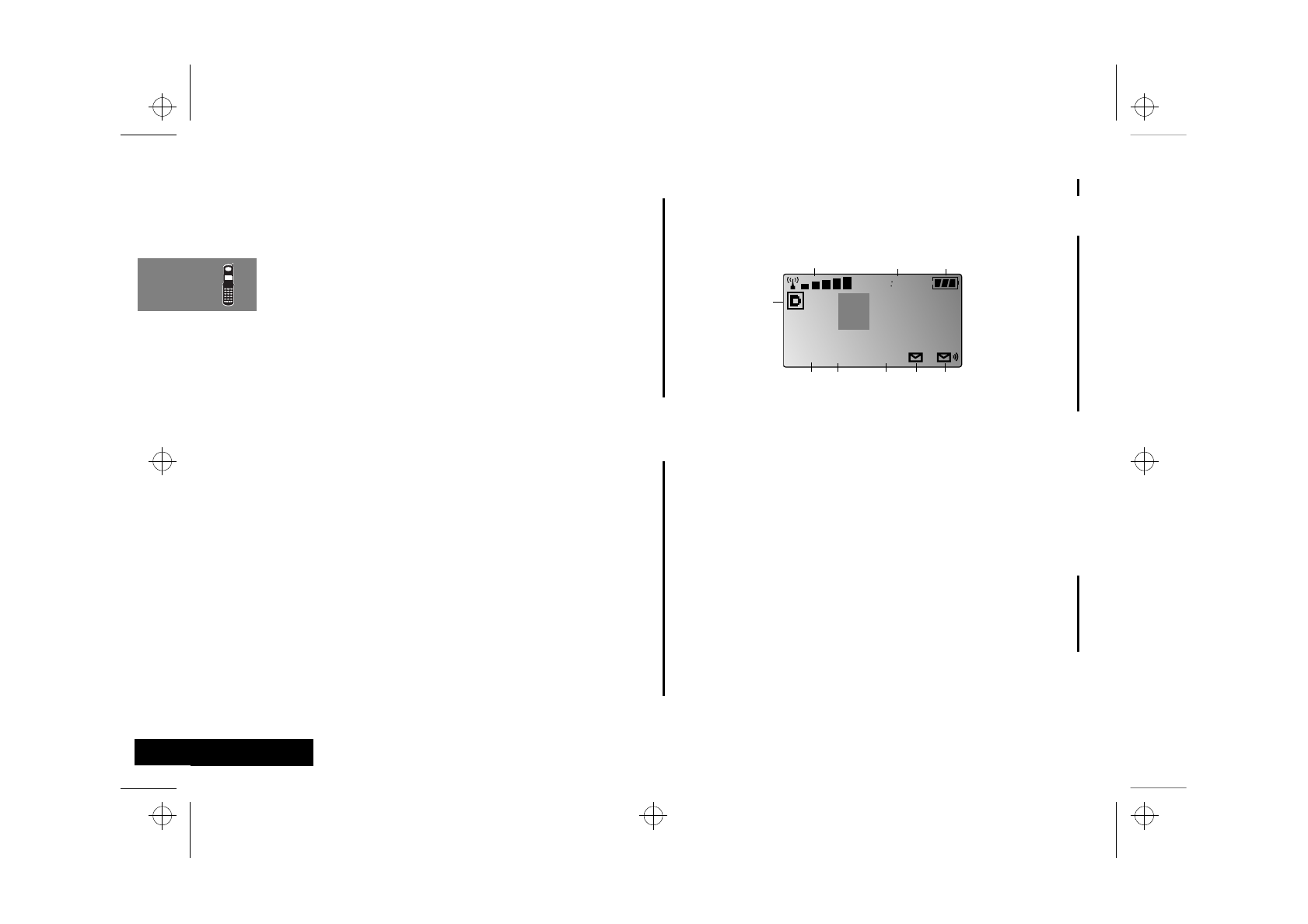
About Your Phone and Battery
14
English
Placing and Ending a Call
To place a call when the number you want to call is on the
display, press and hold A. Press and hold A again to end a call.
See “Using Your Phone” on page 19.
Opening the Quick Menu
When your phone is idle, press A to display a menu containing
shortcuts to your phone’s most popular features. See page 22.
Opening Your Phone Book
To open the Phone Book with all your names and numbers, press
A twice. See page 23.
Controlling Volume
Use the upper and lower volume keys to adjust earpiece, keypad,
and ringer volume. When you press these keys, the phone’s
speaker demonstrates the current volume level.
Adjusting Earpiece and Keypad Volume
The audio feedback your phone gives you when you press a key
is called keypad tones. To adjust the volume of the keypad tones,
use the volume keys when your phone is idle.
ATo silence the keypad tones, see page 39
To adjust the volume of your conversation (the earpiece volume)
use the volume keys during a call.
Press q to raise the volume or press Z to lower the volume.
Adjusting Ringer Volume
To adjust ringer volume:
Press Ä q to raise the volume or press Ä Z to lower the
volume.
The Display
The display on your phone can show alphanumeric characters as
well as useful information symbols.The various elements of the
display are as follows
1. rx Signal Strength. The more segments
displayed in the bar graph, the better the
signal strength.
2. D Digital Indicator. If you are in a digital
coverage area, the digital indicator appears.
Your phone operates more efficiently in
Digital mode.
3. IU In Use Indicator. Displayed when a call is in
progress.
4. Rm Roam. Lights up when your phone accesses
a wireless service outside of your home
system. When you leave your wireless
Service Area, your phone roams (seeks
another wireless system).
2512
Rm NSIU
07/07/99
2
34 5 6 7
98
1
abtphone.fm5 Page 14 Tuesday, October 19, 1999 10:21 PM
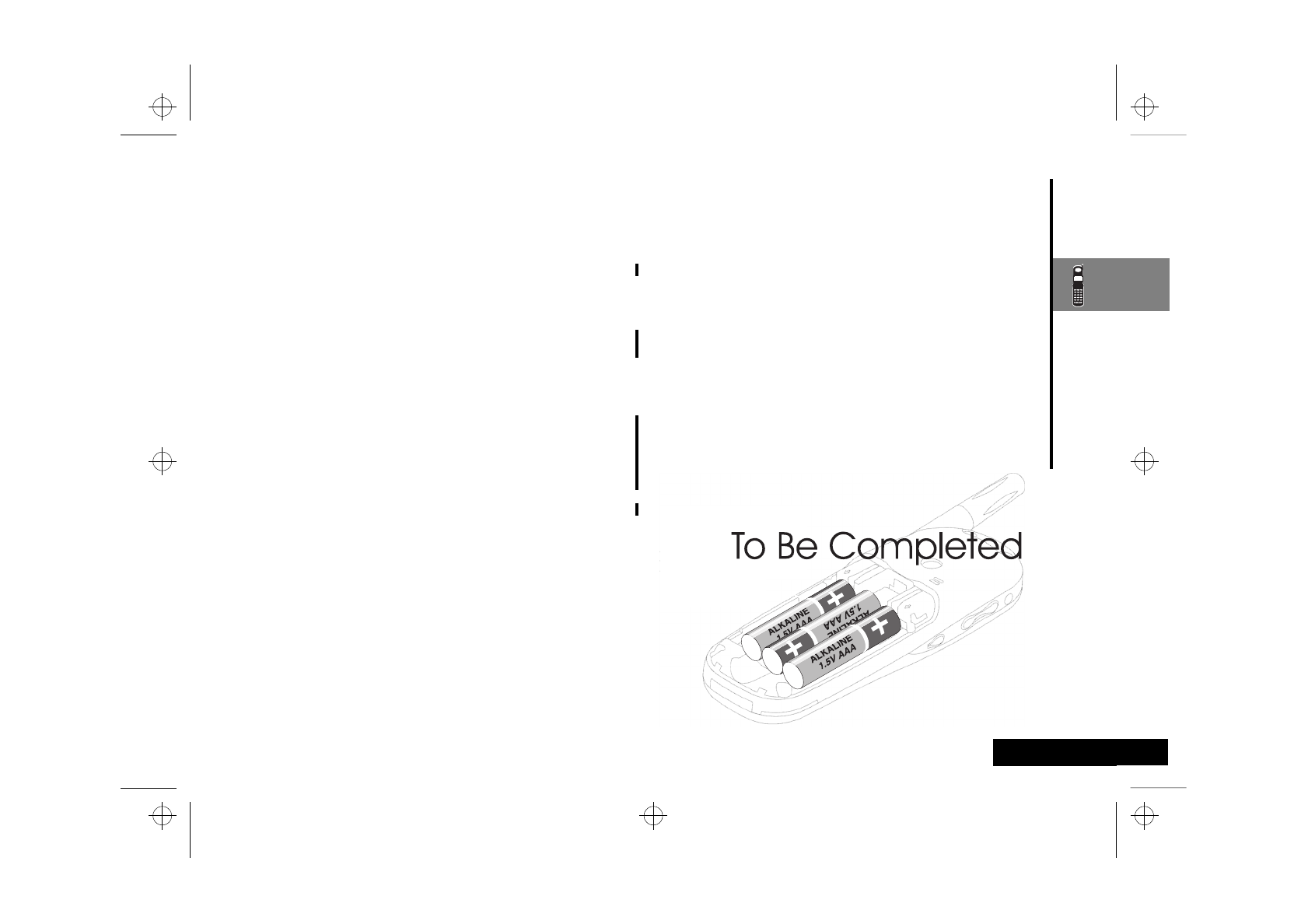
About Your Phone and Battery 15 English
*The availability of this feature depends on your service provider.
Your Battery
Installing the Batteries
New batteries are supplied uncharged and fitted within a
protective battery carrier. To remove the batteries, press the
release catch on the battery carrier and open the cover.
To install the batteries in your phone:
1Press the release catch of the phone battery cover and slide
the battery cover towards the bottom of the phone.
2Align the positive and negative (+ and -) connections on the
battery with the positive and negative (+ and -) connections
within the phone.
3Press the battery towards the connections and push it
downwards until it clicks into place.
4Replace the phone battery cover.
5. NS No Service Indicator. If you travel beyond
the range of a cellular system, the No Service
Indicator appears to let you know that calls
cannot be placed or received from your
location.
6. oShort Message Service*. Displayed when
the phone has received a message. The
symbol will flash when your message storage
area is full.
7. pVoicemail Waiting Indicator*. Displayed
when you have a voice message waiting.
8. qBattery Charge Indicator. The more
segments displayed, the greater the battery
charge.
9. 12:00 Clock. When your phone is using a CDMA
digital network, the display shows the
current local time and date. You can set your
clock for 12- or 24-hour format. See page 99
for more information.
abtphone.fm5 Page 15 Tuesday, October 19, 1999 10:21 PM

About Your Phone and Battery
16
English
Important Battery Information
!Always treat your batteries with care. See ‘Batteries’, at
the beginning of this manual.
!Never leave your battery in extremely high
temperatures (over 60°C), for example behind glass in
very hot, direct sunlight.
!Only Motorola Original Accessory batteries can be
charged in the phone. This is to protect you and your
phone from the risks of incorrect charging.
Charging a New Battery
New batteries are supplied in a totally uncharged state.
To ensure maximum battery performance, a new battery (or
battery that has not been used for several months) should be
charged for at least 14 hours before use.
AA new battery will require several full charge/discharge
cycles in order to achieve its optimum performance.
AA new battery, or a battery that has not been used for
several months, may cause a premature fully charged
indication. Ignore this indication and let the battery charge
for several more hours, remove and re-insert the battery
into the charger, and charge for an additional 14 hours.
!Your batteries will not charge if they are not matched
properly to the phone connection markings (+ and -).
Please ensure that you have installed the batteries
properly before initiating a charge.
To ensure that you enjoy maximum battery life and use your
battery to its fullest capacity:
•The battery should be at or near room temperature when
charging.
Battery Performance and Maintenance
•Best battery performance will be achieved when you regularly
charge and discharge batteries as instructed in this manual.
•Battery performance is greatly affected by network coverage.
•Set Battery Saving Mode to On (see ‘Phone Setup
Menu’) and/or Frequency of Search to Slow or Medium
(see ‘Network Selection Menu’).
•If left unused, a fully charged battery will discharge itself in
approximately one month.
•When not in use, store your battery uncharged in a cool, dark
and dry place.
abtphone.fm5 Page 16 Tuesday, October 19, 1999 10:21 PM

About Your Phone and Battery 17 English
Removing Your Batteries
!Switch off your phone before removing batteries.
Failure to do so may damage your phone memory.
1Press the release catch of the phone battery cover and slide
the battery cover towards the bottom of the phone.
2Remove the batteries.
Charging Your Battery Using the Travel
Charger
The travel charger can power the phone and charge a fitted
battery.
!Ensure that the local mains voltage at your location
matches that of your travel charger.
Install the batteries into your phone (see ’Installing the Batteries’).
To charge your battery:
1Attach the correct adapter plug to the travel charger.
2Connect the travel charger to the phone.
AThe connector is keyed and can only be inserted one way.
3Insert the travel charger plug into a suitable mains power
socket.
A beep-tone is heard and the battery icon flashes when charging
begins.
AThe beep-tone on the phone will not occur if the batteries
are installed improperly. The beep-tone may take two
minutes to occur with new or fully drained batteries.
abtphone.fm5 Page 17 Tuesday, October 19, 1999 10:21 PM

About Your Phone and Battery
18
English
The state of charging is monitored and displayed by your phone.
See ‘Battery Meter Indicators’ later in this section for details.
Low Battery Warning
When the battery level is low and only a few minutes of talk time
remain, a warning signal (two double beeps) will sound, and Low
Battery will be displayed.
For a detailed battery level reading: Press Ä Ý.
The more segments filled on the battery gauge (Bx), the
greater the charge.
When the battery is completely discharged, your phone will turn
off.
Battery Indicators
Your phone monitors and displays information about your
battery. The following message will appear on the display, as the
condition occurs:
Battery Meter Indicators
The battery meter displays different messages depending on the
batteries attached, and whether or not there is an external power
source. The battery meter is found in the Call Related Features
part of the Options Menu.
AWhen the battery is completely discharged, you must
charge the battery for one minute before you can make or
accept a phone call.
Low Battery The battery charge is low. The battery should
be recharged.
Charging
Battery
The battery is being charged.
Charging
Complete
Charging is complete.
abtphone.fm5 Page 18 Tuesday, October 19, 1999 10:21 PM

Using Your Phone 19 English
Using Your Phone
Placing and Receiving Calls
This section explains how to:
•turn your phone ON and OFF
•place calls, end calls, and receive calls.
•redial phone numbers
•mute your phone
Turning Your Phone On and Off
To turn the phone on:
To turn the phone off, press and hold Á again. Powering off
will be displayed, and you will hear an audible alert.
What You Will See
When you turn on your phone, it performs a self-test to let you
know it is operational and then it scans for a service. While the
phone scans, the display reads: Searching.
When your phone finds a CDMA digital system, you will see the
time and date and the icon.
Power Save Mode
If you travel outside the range of available networks, your phone
continues to search for a signal. To save power, it stops searching
every couple of minutes.
Your phone will automatically begin searching again in a minute
or two – if you would like it to start searching immediately, just
press any key.
Standby Mode
To conserve energy, your phone enters standby mode and turns
off the backlight when you have not touched a key for a few
seconds. The backlight will come back on as soon you press a key
or open the phone.
Placing a Call
To place a call:
1Extend
Antenna
Extend the antenna completely for best
performance.
2Open
Phone
Open the phone to expose the keypad.
3Turn ON
Phone
Press and hold Á until the display appears and
you hear an audible alert.
1Extend
Antenna
Extend the antenna completely for best
performance.
2Open
Phone
Open the phone to expose the keypad. If
necessary, press Á to turn the phone ON.
3Enter
Number
Enter the number you want to call,
for example: 555-1212.
Correct
Errors
Press C to erase one digit at a time if you
make a mistake. Press and hold C to erase the
entire entry and start again.
usephone.fm5 Page 19 Tuesday, October 19, 1999 10:12 PM

Using Your Phone
20
English
AYou can also recall a previously dialed or stored number.
(See “Using Phone Memory” on page 23 for details on
storing or recalling.)
You can dial phone numbers with up to 32 digits, but only the
last 20 digits appear in the display.
Press ä to see the entire phone number.
Your phone will display the first 24 digits, then a second screen
will show the digits remaining in the phone number.
Ending a Call
There are three ways to end a call:
Receiving a Call
Your phone must be powered on to receive calls.
To answer a call:
Caller ID
If Caller ID* is active on your phone, you will be able to see who
is calling before you answer. The display will show either your
caller’s name (if in your Phone Book) or your caller’s number. If
you prefer to always see your caller’s number, see page 32 to
turn Number Preference ON.
The Caller IDs for your last 16 callers will be saved. See page 54
to learn how to view your stored Caller IDs.
Unanswered Call Indicator
Even with the latest wireless technology, sometimes you are
unavailable to answer calls. If your phone is ON, it keeps a count
of unanswered calls. For example, if you miss two calls, your
display will show: 2 Calls Unanswered.
If you subscribe to Caller ID service, you can easily return the calls
that you missed. See page 50 to learn how to return the calls you
missed.
* Contact your Service Provider for availability.
4Place
Call
Press ¾ to place the call.
or
Press and hold A until you hear a high tone.
You will see: Calling 555-1212.
Close Close the phone to end a call.
or Press Key Press ¼.
or Hold Smart
Button
Press and hold A until you hear a high tone. You
will see: Press § to End Call.
Press A again to end the call.
1Extend
Antenna
Extend the antenna completely for best
performance.
2Open
Phone
Open the phone to expose the keypad.
or
Press ¾ if the phone is already open.
Clear
Display
Press C or press ¼ to clear the display,
and you can begin placing calls again.
2512
Smith, Jane
usephone.fm5 Page 20 Tuesday, October 19, 1999 10:12 PM

Using Your Phone 21 English
Call Waiting
If you subscribe to Call Waiting through your Service Provider,
you may hear a tone while on a call, indicating that you are
receiving a second call.
Redialing a Number
Automatic Redial
The wireless system may at times be too busy to handle your call.
If this is the case, you may hear a fast busy signal and see Call
Failed and Press SND to Redial. With Automatic Redial, your
phone will repeat the call attempt over the next four minutes.
When the call succeeds, your phone will ring until the person you
are calling answers.
To use Automatic Redial:
Press ¾ or press and hold A until you hear a high tone. You
will see: Redialing.
To make this feature even easier, turn Instant Redial ON. Your
phone will instantly redial after a fast busy signal, and you will
not have to push a button. To find out more, see page 95.
Redial
If you hear an ordinary busy signal:
Display Last Ten Numbers Dialed
Your phone keeps track of the last ten numbers you have dialed.
Muting the Microphone
For privacy during a call, mute the microphone. You can hear the
person on the other end, but he or she cannot hear you.
Answer Call Press ¾ to answer the call and automatically
place the current call on hold.
or End Current
Call
Press ¼ to end the current call. Your phone
will then ring as usual. Press ¾ to answer the
call.
1Hang Up Press ¼ to hang up.
2Redial Press ¾ to redial.
or
Press and hold A. You will see: Calling.
1Enter
List
Press ä then press â, â. The display will
show the last number you dialed.
2Review List Press q or Z to scroll through the last calls made,
including the time, date, and number.
3Call
Number
Press ¾ or press and hold A to call the number
in your display. You will see: Calling.
Mute
Phone
Press Ä then press ß during a call to mute
the microphone. You will see: Muted.
Unmute
Phone
Press Ä then press ß again to resume your
conversation.
usephone.fm5 Page 21 Tuesday, October 19, 1999 10:12 PM

Using Your Phone
22
English
Using the Quick Menu
Throughout this guide you will see shortcuts that point out
simple ways to reach some of your phone’s features. If you have
owned a Motorola phone before, some of these shortcuts will
already be familiar to you.
The Quick Menu
Press the Smart Button and the Quick Menu opens on the
display.
The Quick Menu contains shortcuts to your phone’s most
popular features. Press the volume keys to scroll through the
options shown below and press the Smart Button to choose one.
The Usual Shortcuts
The words “menu,” “batt,” “lock,” and “mute” appear on the
Ú, Ý, Þ, and ß buttons. Press the Ä key first, then
any one of these buttons, and your phone will perform that
function.
Phone Book The Phone Book is the place to find all your personal
names and numbers. See page 32.
Messaging If you subscribe to messaging, you can use this
shortcut or the one on page 53.
Last 10
Dialed
Your phone remembers the last ten numbers you
dialed. Turn to page 21 to learn more.
Main
Menu
Select this option to access your phone’s menu
system. See page 29 to find out more.
Exit Select this option or press ¼ to exit the Quick
Menu at any time.
Enter
Menu
Press Ä then press Ú to enter the menu
system.
Display
Meter
Press Ä then press Ý to display the
battery meter.
Lock
Phone
Press Ä then press Þ.
You will see: Lock? Press  to lock.
Mute
Phone
Press Ä then press ß to toggle mute ON and
OFF during a conversation.
usephone.fm5 Page 22 Tuesday, October 19, 1999 10:12 PM

Using Your Phone 23 English
Using Phone Memory
Use your phone’s internal Phone Book to store up to 99 names
and numbers for easy access.
In this section you will learn how to:
•store names and numbers into the Phone Book
•recall phone numbers from memory
•clear names and numbers
•dial a number with Speed Dial and Turbo Dial™
•make notes on the scratchpad
•store numbers with pause dialing
•store calling card sequences for easy access
Using Your Phone’s Built-in Phone Book
Each phone number in your phone book is stored in a memory
location numbered 01-99.
Arrange numbers for easy recall by storing related numbers in
groups. If you store the numbers you call most in locations 01-
09, then you can use Turbo Dial™ to call those numbers with a
single key. (See “Using the Turbo Dial™ Function” on page 25
for details.) You could store business contacts in locations 10-19,
family in 20-29, friends in 30-39, and so on.
You can also store names to identify phone numbers. Later, you
can recall a number by the name that corresponds to it.
Storing Names and Numbers
Each memory location can store up to four numbers. For a single
contact, you can store every number you need, like home,
mobile, fax, and more.
Keep in mind: Your Phone Book sorts alphabetically by the first
letter in the entry. If you store an entry without a name it will be
placed at the back of the Phone Book
How to Store Phone Numbers
1Enter
Number
Enter the phone number you want to store.
You can store up to 32 digits per phone number
entry.
2Begin
Storing
Press  to begin storing. You will see:
Location xx?. ‘XX’ is the number of the lowest
available location.
3Accept
Location
Press  or Ç to store the sequence in the
displayed location.
or Enter New Press C to erase the location number and
enter a new two-digit location number.
or Select
Range of
Ten
Enter the first digit of the memory location, then
press Ç to store the sequence in the first
available location beginning with that digit. For
example, if you store personal numbers in the
twenties, press 2Ç.
4Enter Name Enter a name to identify the phone number. (See
the following section for details on entering
names.)
Press a or  when finished. Your phone will
confirm the entry by displaying the information
stored.
usephone.fm5 Page 23 Tuesday, October 19, 1999 10:12 PM
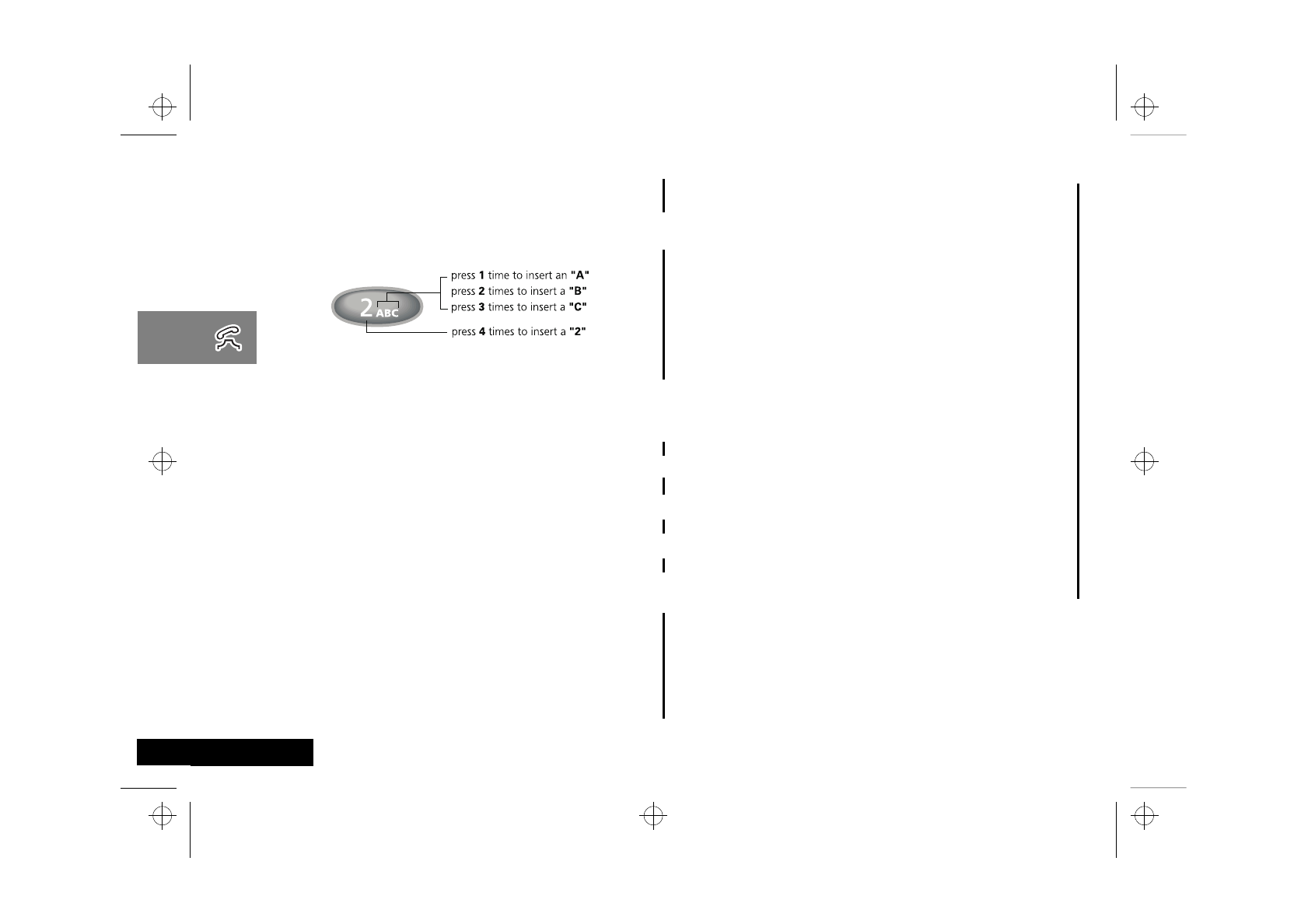
Using Your Phone
24
English
How to Enter Names
When the display shows Alpha Or §, you can press the numeric
keys one or more times to produce any letter or number in the
alphabet. Use the letters printed on each key as a guide. For
example, press Û to enter “A,” “B,” “C,” or “2” as shown: Recalling an Entry by Name
After storing names and numbers, you can recall them
alphabetically and immediately place calls.
1Enter
Letter
Press a key as many times as necessary to enter a
letter. The next letter on the key will appear with
each press.
Toggle Case Press q or z to switch between upper and
lowercase.
2Advance
Cursor
After each character, press È to advance the
cursor to the next space.
Clear
Letter
Press C to erase a letter if you make
a mistake.
Back Space Press Ç to move the cursor backward if you
would like to insert a letter earlier in the
sequence.
3Choose
Label
Press 0 to scroll through the available labels.
After 0, you will see Home, Mobile, Pager, or
Work.
4Enter Marks Press Ú to scroll through the available
punctuation marks: <space> 1 ! " $ % & ' @
( ) + , - . / \ : ; < = > ? [ ] _ * #.
5Finish
Storing
Enter up to 20 letters. Press a when you are
finished. Your phone will confirm the entry by
displaying the information stored.
1Enter Press a twice to enter your name directory.
2Scroll to
Name
Press q or z to scroll to the name you are looking
for.
or Search for
Name
Enter the first letter of the name. The display will
show the name and memory location of the first
entry beginning with that letter, and an icon for
each number stored in the entry (up to four).
3Place
Call
Press and hold a or press ¾ to call the
number. You will see: Calling.
4End
Call
Press ¼ or close the phone.
or
Press and hold a until you hear a high tone.
You will see: Press § to End Call.
then
Press a again.
usephone.fm5 Page 24 Tuesday, October 19, 1999 10:12 PM

Using Your Phone 25 English
Recalling an Entry by Memory Location
Each name and number you store is placed in a memory location
numbered 01-99. Once you have stored names and numbers,
you can recall them by memory location:
Clearing a Phone Memory Entry
To erase a memory entry:
Shortcuts for Recalling Phone Book Entries
Using Speed Dial
If you know the memory location of the number you want to call,
try the Speed Dial function:
Using the Turbo Dial™ Function
The Turbo Dial™ function enables you to dial numbers stored in
locations 01-09 with the push of a single button:
Your phone’s Priority Call feature gives you fast access to any
number stored in location 01. To learn more about this feature,
see “Priority Call” on page 42.
1Begin Press ä to begin recalling.
2Enter
Location
Enter the two-digit memory location of the phone
number you are looking for.
3Place
Call
Press and hold a or press ¾ to call the
number. You will see: Calling.
4End
Call
Press ¼ or close the phone.
or
Press and hold a until you hear a high tone.
You will see: Press § to End Call.
then
Press a again.
1Recall Entry Press a twice and then press q or z to scroll to
the name you are looking for.
or
Press ä and the two digit location number of
the entry.
2Clear Entry Press C to clear the entry.
You will see: To Delete Press STO.
3Confirm
Erase
Press  to confirm that you want to
erase the entry.
1Enter
Location
Enter the two-digit memory location of the phone
number you are looking for.
2Place
Call
Press and hold a or press ¾ to call the
number. You will see: Calling.
Turbo
Dial
Press and hold the memory location number of
the entry you want to call, Ú through á,
and your call is placed. You will see: Calling.
usephone.fm5 Page 25 Tuesday, October 19, 1999 10:12 PM

Using Your Phone
26
English
Making Notes on the Scratchpad
In addition to your internal phone book, you also have a built-in
scratchpad for making quick notes. The scratchpad remembers
the last phone number shown on your display.
Entering a Number in the Scratchpad
If you are on the phone and your party gives you another number
to call, enter the number on the scratchpad so you can place the
call later.
Pause Dialing
When you call automated systems like Voice Mail or bank by
phone, a recorded message prompts you for PIN numbers,
account numbers, etc. Pause Dialing can make using automated
systems easy by allowing you to store these numbers in the same
memory location as the automated system’s access number.
Separate each set of numbers with a “pause”– a special
character that tells your phone to wait before sending additional
numbers.
Storing a Number with Pause Dialing
The pause occupies a one-digit space in your phone’s memory.
Once you have entered a string of numbers and pauses, store the
string in the same way you store other entries.
You can store up to 32 digits, including pauses.
1Enter
Number
Enter the number with the keypad. (The person
on the line will hear tones as you dial.)
2Store
Number
Press Â, enter a two-digit location, enter a
name with the keypad, and press  to finish.
See page 23 for more details.
or End
Call
Press ¼ to end your current call if necessary.
and Place
Call
Press ¾ to call the number in the Scratchpad.
1Enter
Number
Enter the phone number you use to access the
automated system.
2Insert
Pause
Press Ä and press ¾. You will see: Insert
Pause o. Press a. You will see a pause circle o
inserted into the number entry.
3Enter
PIN
Enter the next group of numbers, for example,
your PIN number. If the automated system
requires a * or #, enter those symbols, too.
4Insert More
Pauses
Repeat steps 2 and 3 as many times as necessary.
5Store
Sequence
Press Â. Enter a two-digit location, select a
label, enter a name if you like, and press  or
a when finished. Your phone will confirm the
entry by displaying the information you stored.
usephone.fm5 Page 26 Tuesday, October 19, 1999 10:12 PM

Using Your Phone 27 English
Using Pause Dialing
Once stored, you may recall the entry and place the call. All of the
digits you have stored will be recalled, but your phone will only
send the tones for the set of numbers before the first pause.
Using Memory Linking
Each memory location holds up to 32 digits, including pauses.
Some automated systems, however, may require you to enter
more than 32 digits. If this is required, split the numbers into two
memory locations and recall the second set of digits as you need
them.
Using Calling Cards
Storing Calling Card Numbers
Number Characters are another way your phone can save you
time in dialing. The Number Character saves a place in the
memory sequence for whatever number you are calling when
you use your calling card. For best results, you may use the
Number Character along with Pause Dialing.
AYou can protect your calling card information with your
phone’s call restriction features. See page 86 for details.
1Place
Call
Enter the two-digit memory location of the Pause
Dialing number and press and hold a or press
¾ . Your phone will dial the access number
and wait for your input when it reaches the first
pause.
2Send More
Numbers
When the automated system prompts you for
information, press a or ¾ to send the next
group of numbers. Repeat this step to send each
group of numbers that you have stored.
3End
Call
Press ¼, close the phone, or press and hold a
until you hear a high tone and press a again.
1Recall 2nd
Location
Once you have sent the tones from the 1st
location, press ä and the two-digit memory
location where you stored the second set of
digits.
2Send Tones Press ä and ¾ to send the tones in the 2nd
location. If you have stored a pause in the 2nd
location, your phone will pause as usual when it
reaches the pause character.
1Enter
Access
Number
Enter the phone number you use to access the
calling card system, usually a 1-800 phone
number. Skip this step if you only dial 0.
2Insert
Pause
Press Ä then press ¾ . You will see:
Insert Pause o. Press a.
3Insert
Number
Character
Press Ä then press ¾. Press q or Z to scroll
to Insert Number 'N. Press a. You will see the
number character 'N inserted into the sequence.
This special character saves a place for the
number you will be calling when you use your
calling card.
4Insert
Pause
Press Ä then press ¾ then a as in step 2.
5Enter
Code
When you use your calling card, the system
prompts you for an access code, usually a PIN
code. Enter this number. Repeat steps 4 & 5 if
your card requires more access codes.
6Store
Sequence
Press Â. Enter a two-digit location, select a
label, enter a name if you like, and press  or
a when finished. Your phone will confirm the
entry by displaying the information you stored.
usephone.fm5 Page 27 Tuesday, October 19, 1999 10:12 PM

Using Your Phone
28
English
Placing a Calling Card Call
Once you have stored your calling card information, recall the
information and place the call whenever you want to use your
calling card. Before your phone begins dialing, it will prompt you
for the number you want to call. Once you have entered the
number, your phone will automatically insert the number in place
of the Number Character you stored.
1Recall
Entry
Press ä then enter the location number where
your calling card sequence is stored.
2Enter
Number
Press ¾. You will see: Enter Number. Enter
the phone number you are calling. You may enter
the number manually or recall it by location.
3Place
Call
Press and hold a to place the call. Your phone
will dial the number to access your long distance
provider, then wait for your input when it reaches
the first pause.
4Send
More
Numbers
Press a or press ¾ to send the next group of
numbers when the recording prompts you. The
phone will automatically insert the number to call
at the appropriate spot in the sequence. Press a
to send each set of numbers until finished.
5End
Call
Press ¼, close the phone, or press and hold a
until you hear a high tone, and press a again to
end the call.
usephone.fm5 Page 28 Tuesday, October 19, 1999 10:12 PM

Using the Menu Features 29 English
Using the Menu Features
Using the Menu System
Your cellular phone includes many features that can help make
life easier and more productive. The phone’s user-friendly menu
system helps you find what you need quickly and easily.
In this section you will learn:
•what are the main menu features
•how to navigate through the menus
•how to read a menu road map
Introducing the Menu Features
As you scroll through the menu system, you will see the following
icons, each representing a high-level menu.
Navigating the Menu
You can navigate through the menu system using the three keys
located on the left side of the phone. Use the upper and lower
volume keys to scroll to sub-menus and to control volume. Use
the middle Smart Button to choose menus and functions.
Follow these symbols as a guide for using the keys on the side of
your phone:
Press q to scroll up.
Press A to select.
Press Z to scroll down.
You can also use your phone’s Ç and È keys to scroll
through the menu system.
Road Maps
To help you navigate through the phone’s menu system, each
section begins with an easy-to-follow visual “road map.” To
enter the menu features:
Detailed instructions within each section describe how each
feature works.
B
Phone Book Lock/Secure
T
Timers
P
Phone Options
Tone Control
1Enter
Menu
Press Ä, then press A.
or
Press Ä Ú. “menu” is printed on the Ú
key as a reminder.
2Scroll
through
Menu
Press qZ to scroll through the menu’s top
level.
3Exit
Menu
Press ¼ to exit the menu.
opt_menu.fm5 Page 29 Tuesday, October 19, 1999 10:31 PM
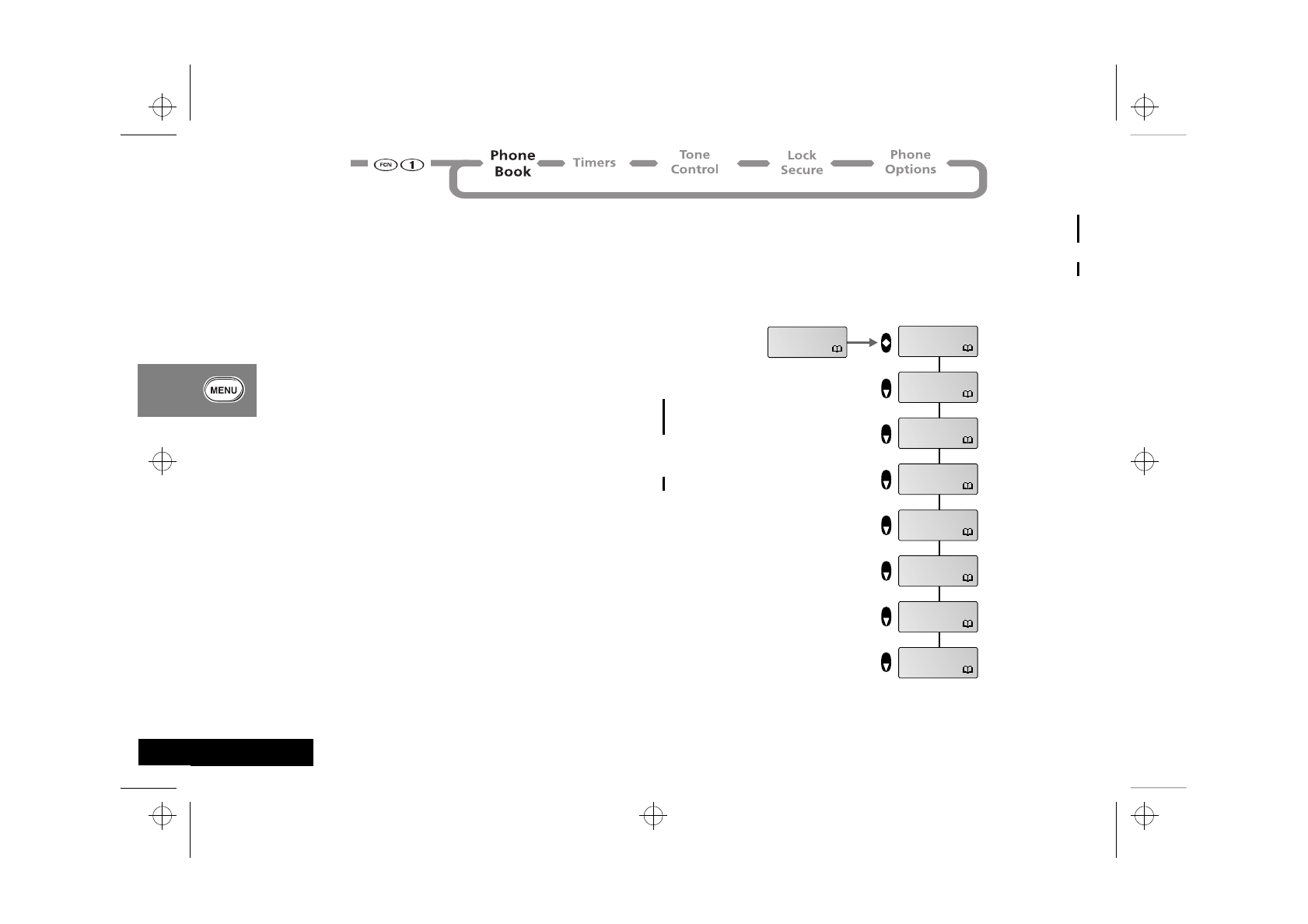
Using the Menu Features
30
English
Managing the Phone Book B
In “Using Phone Memory” you learned how to store and recall
phone numbers with the internal Phone Book. You can access
the same features, along with several advanced features, using
your phone’s convenient menu system.
In this section you will learn how to:
•recall and store phone numbers using the menu system
•edit your memory information
•add numbers to existing entries.
•view your own phone number.
AYou can also recall phone numbers without using the Phone
Book. See “Recalling an Entry by Name” on page 24 or
“Recalling an Entry by Memory Location” on page 25.
Start:
Phone
Book
Recall By
Name
Recall By
Location
Phone Book
Status
Store New
Number
Edit
Memory
View My
Number
Number
Prefer Off
To Main
Menu
opt_menu.fm5 Page 30 Tuesday, October 19, 1999 10:31 PM
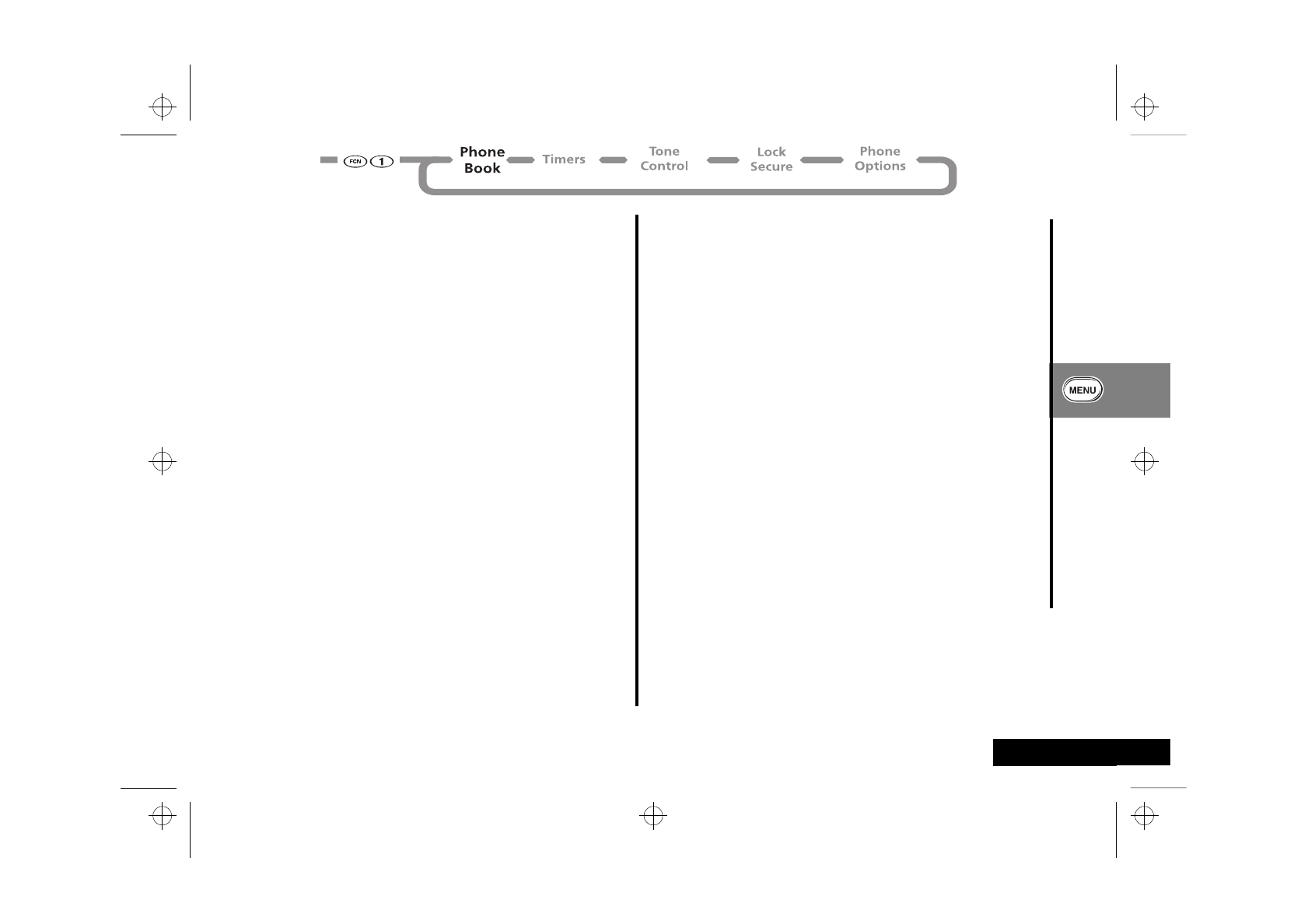
Using the Menu Features 31 English
Recalling an Entry by Name
Once you have stored entries, you can recall them alphabetically
with the Phone Book menu. Find the name, choose the number,
and instantly place a call.
Recalling an Entry by Location
Each name and number you store is placed in a memory location
numbered 01-99. After storing names and numbers, you can
recall them by memory location with the Phone Book menu.
ATo place a quick call just enter the two-digit location and
press ¾.
Phone Book Status
You can use this feature to see how many of your Phone Book’s
99 locations have been used.
1Begin
Recalling
Press a to select Recall By Name. You will see:
Enter 1st Letter.
2Enter
First Letter
Press the appropriate digit key as many times as
necessary to enter the first letter of the name.
(See page 24 for help entering letters.) You will
see the first entry with that letter.
3Find
Name
If necessary, press q or Z to scroll to the name
you are looking for.
4Place
Call
Press and hold a or press ¾ to call the
displayed number. You will see: Calling.
5End
Call
Press ¼ or close the phone.
or
Press and hold a until you hear a high tone.
You will see: Press § to End Call.
then
Press a again.
1Begin
Recalling
Press q or Z to scroll to Recall By Location
and press a to select.
2Enter
Location
Enter the two-digit memory location of the
number you are looking for. You will see the
name, location number, and an icon for each
number stored in the entry.
3Place
Call
Press and hold a or press ¾ to call the
displayed number. You will see: Calling.
4End
Call
Press ¼ or close the phone.
or
Press and hold a until you hear a high tone.
You will see: Press § to End Call.
then
Press a again.
1Select
Feature
Press q or Z to scroll to Phone Book Status and
press a to select. You will see: XX Full XX
Empty.
2Exit
Menu
Press ¼ to exit menu, or you may scroll to
other features.
opt_menu.fm5 Page 31 Tuesday, October 19, 1999 10:31 PM

Using the Menu Features
32
English
Storing a New Number
This feature allows you to create a new entry in the internal
Phone Book. To add a number to an existing entry, turn to
Editing a Memory Location on page 33.
AAlways store your Voice Mail number in location 98.
Viewing Your Number
iPress ä È.
Use this feature to view your phone’s currently active number.
Number Preference
When Placing Calls:
If you prefer to see the number (Calling 555-1212) instead of
the name (Calling Jane Smith) when you place a call from the
internal Phone Book, turn Number Preference ON.
When Receiving Calls:
If you subscribe to Caller ID, your phone automatically looks up
callers in your Phone Book and displays the name stored in the
entry. If you prefer to see the caller’s number (555-1212), then
turn Number Preference ON.
1Begin
Storing
Press q or Z to scroll to Store New Number and
press a to select. You will see: Enter Number.
2Enter
Number
Enter the number you want to store and
press a. You will see: Location XX?. ‘XX’ is the
number of the lowest available location.
3Enter
Location
Press  or Ç to store the number in the
displayed location or enter a new two-digit
location and press Â.
or Select
Range of
Ten
Enter the first digit of the memory location and
press Ç to store it in the first available location
beginning with that digit.
4Enter
Name
Enter a name to identify the phone number(s) or
continue with step 5. See page 24 for details on
entering names.
5Store
Number
Press  or a. Your phone will confirm the
entry by displaying: Stored At XX.
If the name or number is already in your Phone
Book, you will see: Duplicate Name or
Number.
6Exit
Menu
Press ¼ to exit menu, or you may scroll to
other features.
1View
Number
Press q or Z to scroll to View My Number and
press a to select. The display will show the
currently active number.
2Exit
Menu
Press ¼ to exit the menu, or you may scroll to
other features.
1Find
Feature
Press q or Z to scroll to Number Prefer.
2Toggle
Feature
Press a to toggle the feature On or Off.
3Exit
Menu
Press ¼ to exit the menu, or you may scroll to
other features.
opt_menu.fm5 Page 32 Tuesday, October 19, 1999 10:31 PM

Using the Menu Features 33 English
Editing a Memory Location
You can use this feature to add a number to an entry, change
an old number, or duplicate an entry to make a similar one.
1Begin
Editing
Press q or Z to scroll to Edit Memory and press a
to select.
2Find by
Location
Press q or Z to scroll to Edit By Location and press
a to select. You will see: Location——. Enter the
two-digit memory location of the phone number
you want to edit. Press a or  and continue
with Step 3.
or Find by
Name
Press q or Z to scroll to Edit By Name and press
a to select. You will see: Enter 1st Letter.
Enter the first letter of the name you want to edit.
(See page 24 for information on entering letters.
You will see the first entry beginning with that
letter. Press q or Z to scroll to the name you are
looking for. Press a or  and continue with
Step 3.
3Edit /Add
Phone
Number
Enter digits. Press C to erase a digit at a
time, or press and hold C to erase the entire
number. Press Ç to move the cursor
backward.
4Finish
Number
Press a or  when you finish the phone
number.
5Change
Original
If you would like to save your changes in the same
location, then press a or Â. You will see the
name associated with the entry.
or Copy
Entry
If you would like to move the entry to a new
location and keep the original entry, then press
and hold to erase the location and enter a new
two-digit location. You will see the name
associated with the entry.
6Edit
Name
Press C to erase one letter at a time, or press
and hold C to erase the entire name. Press
Ç to move the cursor backward. (See page
24 for details on entering names.) Skip this step
to leave the name unchanged.
7Confirm
Changes
Press a or  when you finish editing the
name. You will see: Location XX is Full. The
display wil then show the new information and
you will see: Change? Press a or  again to
save your changes. You will see: Stored At XX.
8Exit
Menu
Press ¼ to exit the menu, or you may scroll to
other features.
opt_menu.fm5 Page 33 Tuesday, October 19, 1999 10:31 PM
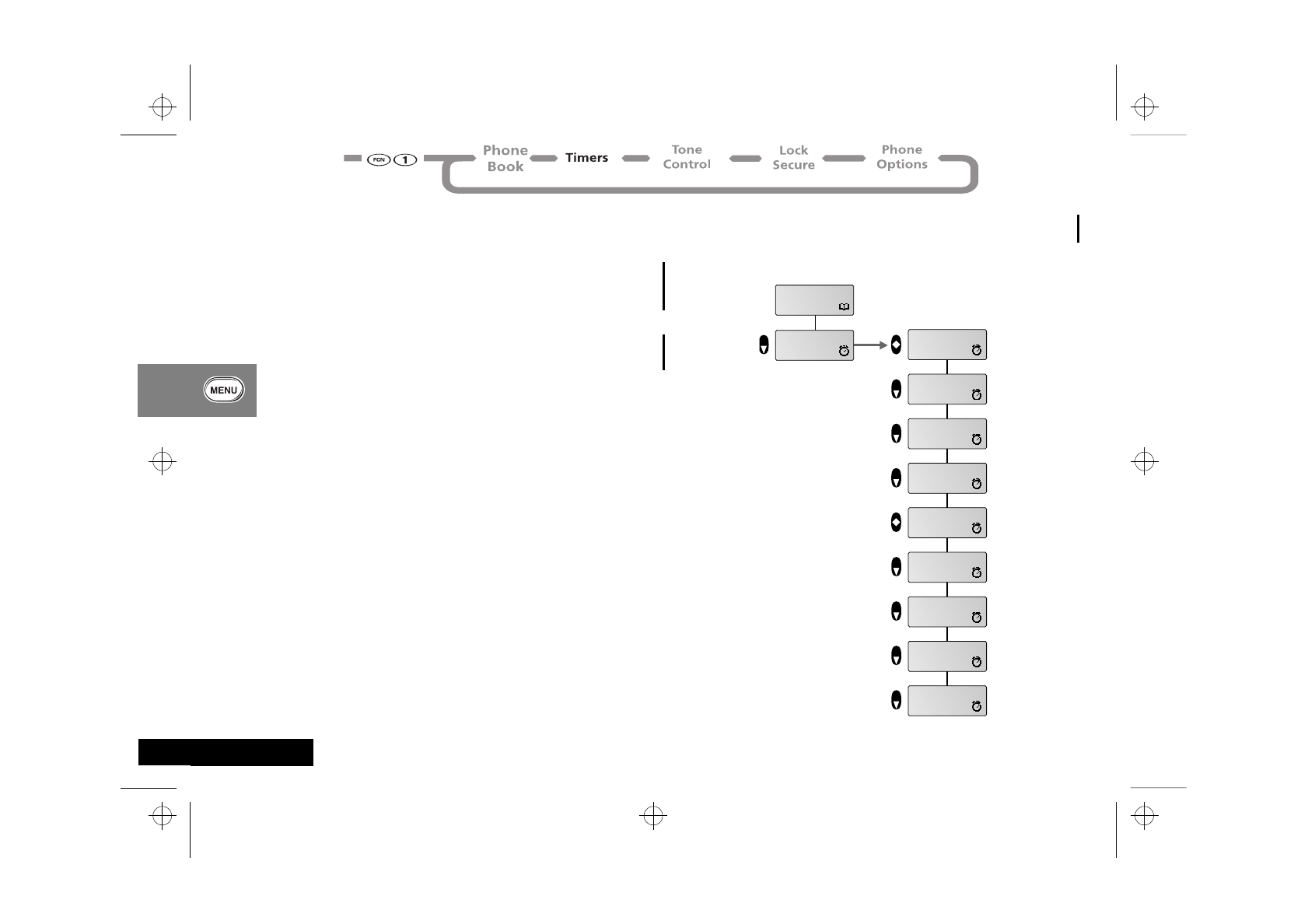
Using the Menu Features
34
English
Timing Your Calls T
Your phone is equipped with three visual and three audible call
timers. You can monitor or record the length of individual calls,
set a timer to track monthly usage, or have the phone alert you at
intervals that you specify.
In this section you will learn how to:
•monitor the length of your calls
•set and view the resettable timer for long-term monitoring
•program audible timers for your individual needs
Start:
Phone
Book
Timers Individual
00:00:00
Cumulative
Time 00000
Reset
Timer
Individual
Timer Off
One Minute
Timer Off
Repeating
Timer Off
Single
Timer Off
To Main
Menu
Resettable
Time 00000
opt_menu.fm5 Page 34 Tuesday, October 19, 1999 10:31 PM
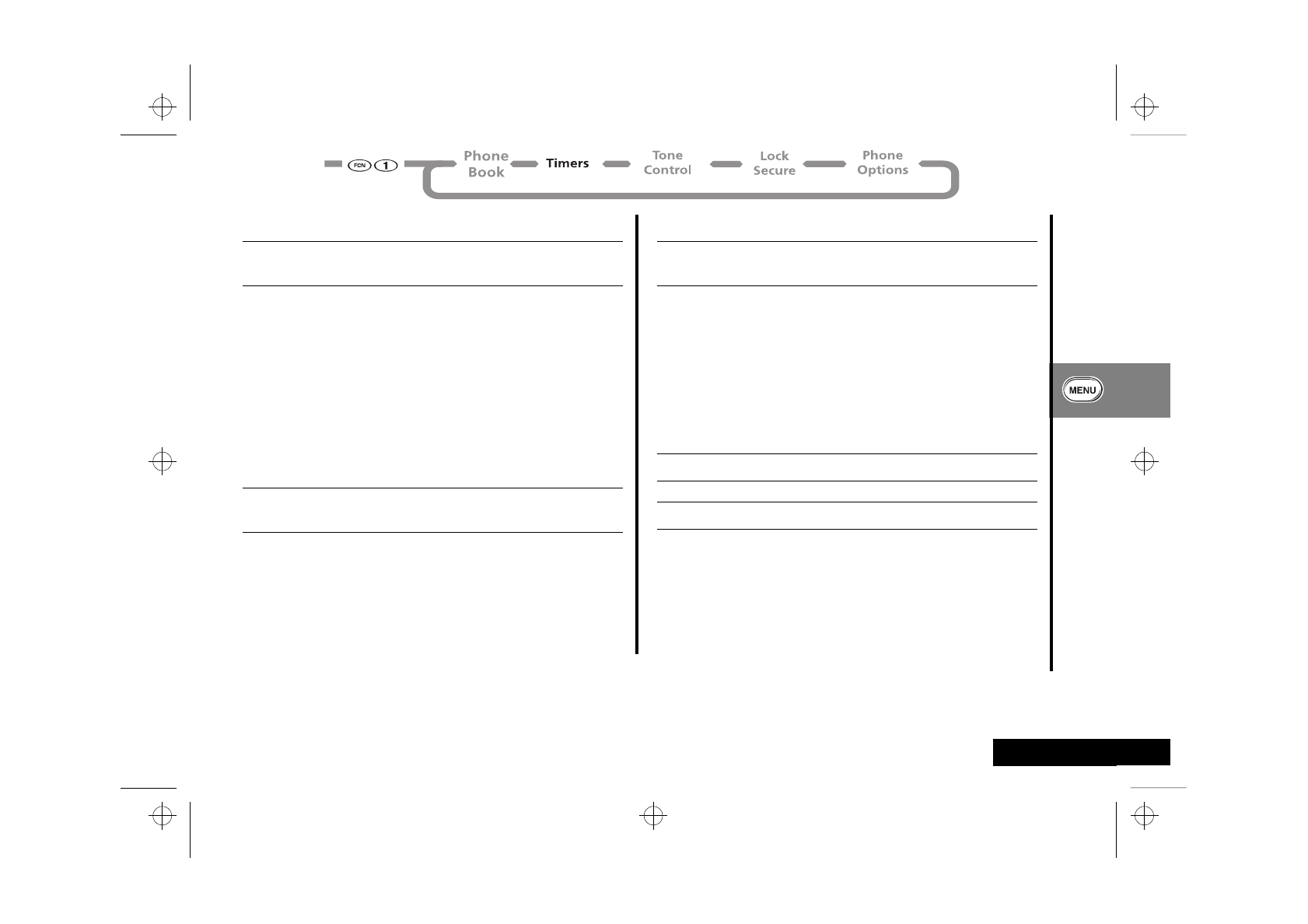
Using the Menu Features 35 English
Viewing the Individual Timer
i1) Press ä then È two times.
or 2) Press Ä, a then Ý, 5.
The individual timer records the air-time of your most recent call
in hours, minutes, and seconds. It resets before you place the
next call. You can have the timer display automatically while calls
are in progress. See “Auto Display Individual Timer” on page 36.
Viewing the Resettable Timer
i1) Press ä then È three times.
or 2) Press Ä, a then Ý, 5.
You can track how much air-time you have accumulated during
any time period you choose. For example, reset this timer at the
beginning of each billing period to know where you stand at any
given moment. Use this feature to view the time elapsed, and
follow the instructions on page 35 to reset the timer.
Viewing the Cumulative Timer
i1) Press ä then È four times.
or 2) Press Ä, a then Ý, 7.
This is a non-resettable timer that keeps track of your phone’s
total air-time (in minutes) since your phone was activated.
Resetting the Timer
iPress Ä, a then Ý, Ü and continue with step 2.
iPress Ä then â, à, C to reset the timer.
This feature allows you to monitor elapsed air-time over a period
of time that you choose. After you reset the timer, it will continue
to keep track of your air-time (in minutes) until you reset it again.
1View
Timer
When you enter the Call Timers menu, you will
see: Individual XX:XX:XX.
2Exit
Menu
Press ¼ to exit the menu, or you may scroll to
other features.
1View
Timer
Press q or Z to scroll to Resettable Time. You
will see the air-time in minutes since you last reset
the timer.
2Exit
Menu
Press ¼ to exit the menu, or you may scroll to
other features.
1View
Timer
Press q or Z to scroll to Cumulative Time. You
will see the total air-time in minutes.
2Exit
Menu
Press ¼ to exit the menu, or you may scroll to
other features.
1Find
Feature
Press q or Z to scroll to Reset Timer.
2Reset
Timer
Press a to reset. You will see: Resettable Time
00000.
3Exit
Menu
Press ¼ to exit the menu, or you may scroll to
other features.
opt_menu.fm5 Page 35 Tuesday, October 19, 1999 10:31 PM

Using the Menu Features
36
English
Auto Display Individual Timer
iPress Ä, a then Ý, 8 and continue with step 2.
When you turn this feature ON, your phone will automatically
display your air-time in minutes and seconds during and after
each call.
AActivating the Auto Display Timer may reduce standby-time
and talk-time.
One Minute Audible Timer
iPress Ä, a then Ý, 4 and continue with step 2.
Turn this feature ON to hear an audible beep 10 seconds before
the end of every minute during a call. The party on the other end
will not hear the beeps.
Repeating Audible Timer
iPress Ä, a then Ý, 1 and continue with step 2.
You can set this timer to beep during your calls at an interval that
you select—from 11-999 seconds. Like the One Minute Timer,
you will hear the beep 10 seconds before the end of each
interval, and the party on the other end will not hear the beeps.
1Find
Feature
Press q or Z to scroll to Individual Timer.
2Toggle
Display
Press a to toggle On or Off the automatic display
of the individual timer.
3Exit
Menu
Press ¼ to exit the menu, or you may scroll to
other features.
1Find
Feature
Press q or Z to scroll to One Minute Timer.
2Toggle
Timer
Press a to toggle the timer On or Off.
3Exit
Menu
Press ¼ to exit the menu, or you may scroll to
other features.
1Find
Feature
Press q or Z to scroll to Repeating Timer.
2Toggle
Timer
Press a to toggle the timer On or Off.
3Enter
Seconds
If you toggle the timer ON, you will see: Enter
Seconds. Enter the number of seconds you would
like between beeps and press a to set the timer.
You will see: Set At XXX Secs.
4Exit
Menu
Press ¼ to exit the menu, or you may scroll to
other features.
opt_menu.fm5 Page 36 Tuesday, October 19, 1999 10:31 PM

Using the Menu Features 37 English
Single Audible Timer
iPress Ä, a then Ý, 2 and continue with step 2.
You can set the Single Timer to beep during your calls at a time
that you select–from 11-999 seconds. It will beep once during
each call, 10 seconds before the end of the preset time. The party
on the other end will not hear the beeps.
1Find
Feature
Press q or Z to scroll to Single Timer.
2Toggle
Timer
Press a to toggle the timer On or Off.
3Enter
Seconds
If you toggle the timer ON, you will see: Enter
Seconds. Enter the number of seconds you would
like before the beep and press a to set the timer.
You will see: Set At XXX Secs.
4Exit
Menu
Press ¼ to exit the menu, or you may scroll to
other features.
opt_menu.fm5 Page 37 Tuesday, October 19, 1999 10:31 PM
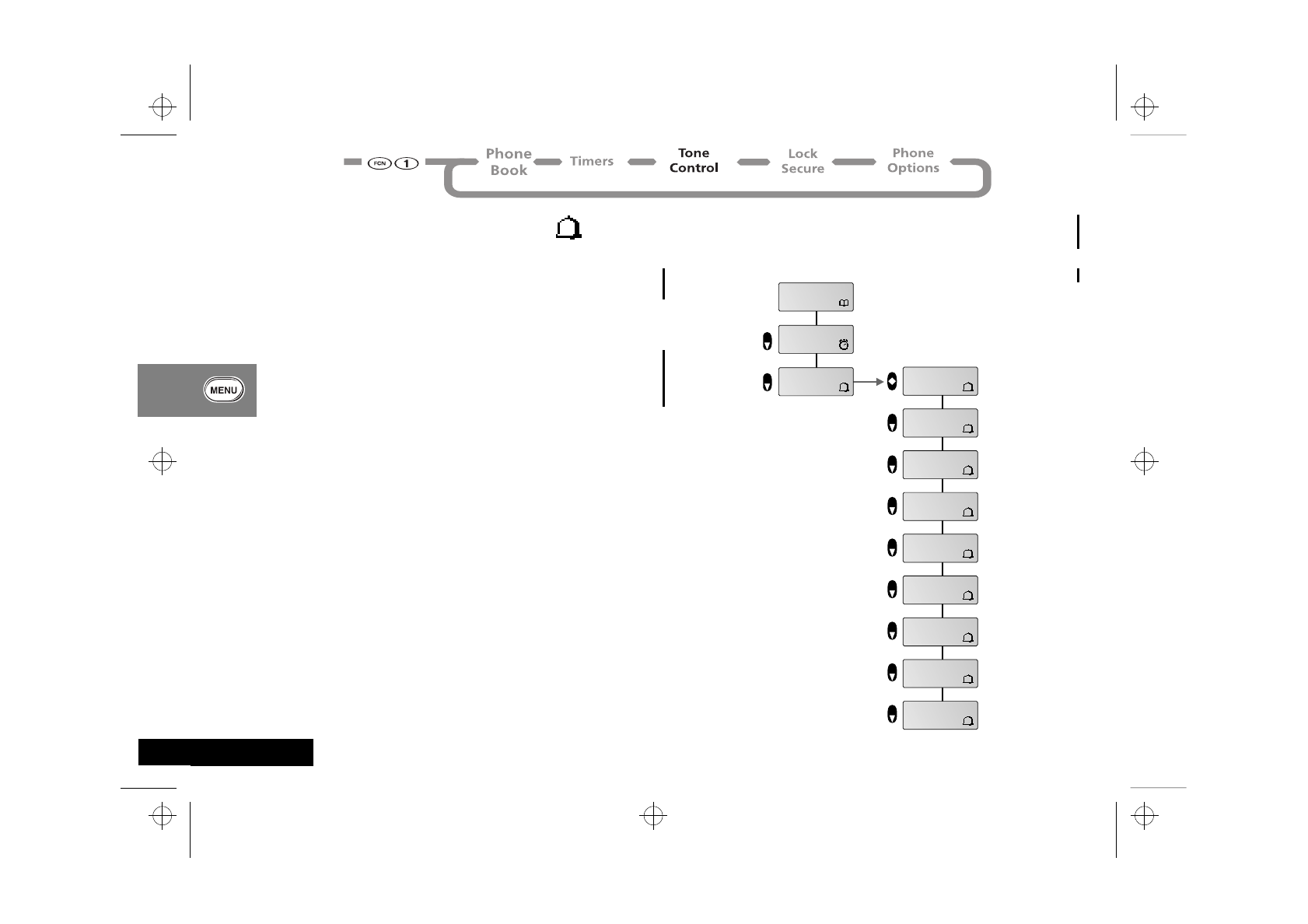
Using the Menu Features
38
English
Adjusting Tone Controls
Use these features to personalize your phone’s ringer styles, or
set the phone to remind you of new messages.
In this section you will learn how to:
•choose from nine different ringer styles
•silence the keypad
•silence all your phone’s tones with one convenient feature.
•set the Message Reminder.
Start:
Phone
Book
Timers
Tone
Control
Silent
Mode Off
Ring/Vib
Select
Ringer
Style 1
Setup Msg
Tones
Reminder
TonesSetup
Keypad
Tones On
DTMF
Select
Service
Tones Off
To Main
Menu
opt_menu.fm5 Page 38 Tuesday, October 19, 1999 10:31 PM

Using the Menu Features 39 English
Selecting a Ringer Style
Your new phone offers nine different ringer styles. After you
choose a style, the phone will give you a brief sample of your new
alert sound.
Setup Message Tones
When you receive a new Voice Mail or alphanumeric message,
your phone beeps three times. To change the number of beeps
or to turn them OFF, use this feature.
Reminder Tones Setup
If you subscribe to messaging services, this feature can help you
remember to check your messages. Turn Message Reminder Tones
ON and your phone will remind you of unread messages by
beeping every two minutes. This feature is especially helpful if you
are busy or away from your phone.
Keypad Tones
iPress Ä, a then 3, 2 and continue with step 2.
Keypad Tones are the sounds you hear when you press any key
on the phone. If you want to be discreet, use this feature to
silence the audio feedback from the keypad.
ATurning Keypad Tones OFF does not silence the tones your
phone sends across the line. See “Transmit Tones” on
page 40 for more information.
1Enter
Feature
Press q or Z to scroll to Ringer Style and
press A to select.
2Select
Ringer
Press q or Z to scroll through the ringer styles. As
you scroll, your phone will give an audible sample
of the currently displayed style. Press A to select
the displayed option.
3Exit
Menu
Press ¼ to exit the menu, or you may scroll to
other features.
1Enter
Feature
Press q or Z to scroll to Setup Msg Tones and
press A to select.
2Select Msg
Type
Press q or Z to scroll to Text Msg Tone or
Voicemail Tone and press A to select.
3Toggle
Tone
Press A to toggle between 3Beep, 1Beep, or Off.
To make new messages easy to recognize, try
making the number of beeps unique to each
message type.
4Exit
Menu
Press ¼ to exit the menu, or you may scroll to
other features.
1Find
Feature
Press q or Z to scroll to Reminder TonesSetup
and press A to select. You will see: CallRemind
Tone.
2Toggle
Feature
Press A to toggle the feature On or Off.
3Exit
Menu
Press ¼ to exit the menu, or you may scroll to
other features.
opt_menu.fm5 Page 39 Tuesday, October 19, 1999 10:31 PM

Using the Menu Features
40
English
Transmit Tones
iPress Ä, a then 3, 3 and continue with step 2.
Your phone transmits tones to communicate with automated
calling systems like Voice Mail or bank by phone. These tones are
called DTMF tones (Dual Tone Multi-Frequency tones), and this
feature allows you to control the length of the tone your phone
sends. For most systems, you should use the default setting of
short tones, which sends the tones for a preset length of time. If
you choose long tones, your phone will transmit the tones for as
long as you press and hold the key. To silence the tones during
conversations, turn the tones OFF.
AIf you turned the DTMF tones OFF, but you want to access a
tone-activated system like Voice Mail, place your call, enter
the numbers you need to transmit and:
Service Tones
When Service Tones are ON, you will be instantly alerted to any
change in your wireless service. You will hear two short beeps
when your phone (1) starts to roam, (2) returns to a home system
after roaming, (3) loses service, or (4) finds service.
AYour phone will always beep if a call is dropped.
1Find
Feature
Press q or Z to scroll to Keypad Tones.
2Toggle
Feature
Press A to toggle the feature On or Off.
3Exit
Menu
Press ¼ to exit the menu, or you may scroll to
other features.
1Enter
Feature
Press q or Z to scroll to DTMF Select and press
A to select.
2Select
Setting
Press q or Z to scroll to Transmit DTMF Long,
Transmit DTMF Short, or Transmit DTMF Off and
press A to select.
3Exit
Menu
Press ¼ to exit the menu, or you may scroll to
other features.
Send Tones Press ä then press ¾ to send the tones if
DTMF tones are OFF.
1Find
Feature
Press q or Z to scroll to Service Tones.
2Toggle
Feature
Press A to toggle the feature On or Off.
3Exit
Menu
Press ¼ to exit the menu, or you may scroll to
other features.
opt_menu.fm5 Page 40 Tuesday, October 19, 1999 10:31 PM
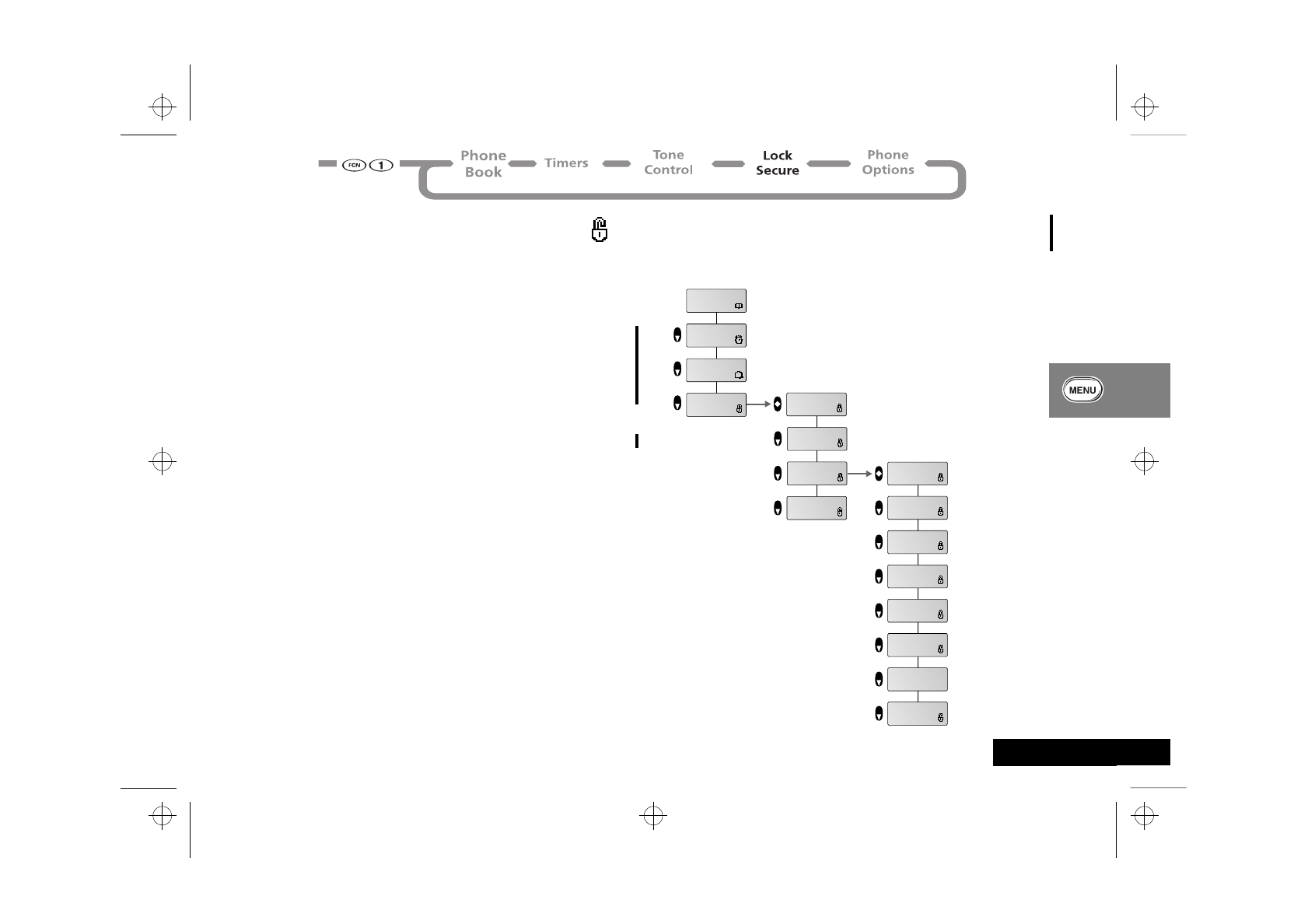
Using the Menu Features 41 English
Using Lock/Security Features
While you probably would not want to leave your phone
unattended, your phone has a number of built-in security
features to prevent unauthorized use.
In this section you will learn how to:
•lock and unlock your phone
•place priority calls
•view and change your lock code
•restrict call placement and memory access
•reset or clear your phone’s settings
Start:
Auto
Lock Off
Priority
Call On
Secure
Options
View Lock
Code
Change
Lock Code
Change
SecureCode
Service
Level 4
Master
Reset
Master
Clear
Secure
Code______
To Main
Menu
To Main
Menu
Phone
Book
Timers
Lock
Secure
Tone
Control
opt_menu.fm5 Page 41 Tuesday, October 19, 1999 10:31 PM
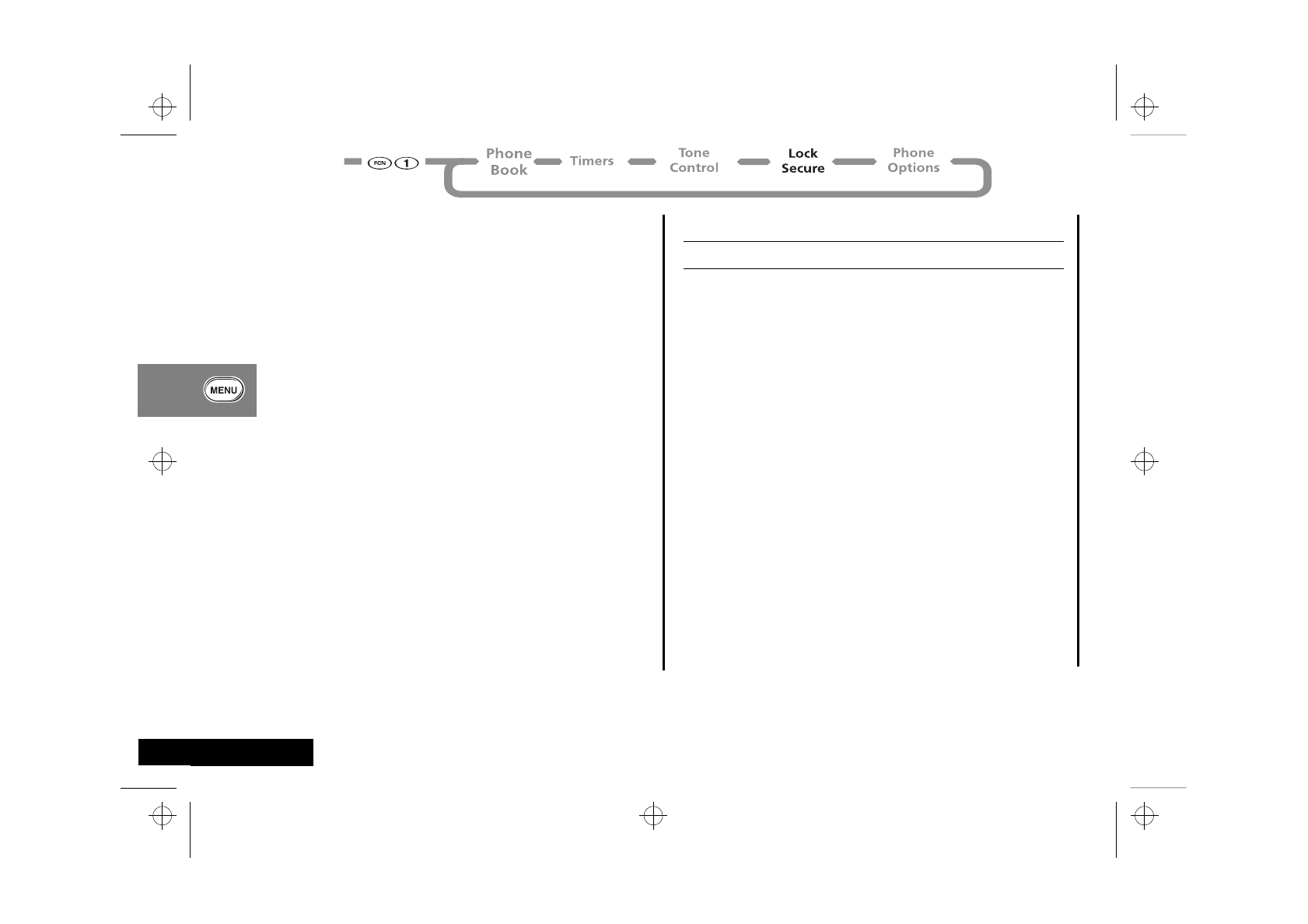
Using the Menu Features
42
English
Auto Lock
Turn this feature ON and your phone will automatically lock itself
each time the phone is turned OFF.
Locking the Phone
You can lock your phone manually at any time to help prevent
unwanted use. Once locked, you can leave the phone ON or turn
it OFF and the phone will remain locked.
Unlocking the Phone
Unlocking your phone is quick and easy. Once your phone is ON,
just enter your three-digit code. Your factory programmed lock
code is 123. If you have changed this code and cannot remember
what it is, see Viewing the Lock Code on page 43.
AYou can still receive calls when the phone is locked. Follow
these steps to answer an incoming call:
Priority Call
iPress Ä, a then 2, 9 and continue with step 2.
Your phone’s priority call feature allows you to instantly place a
call from location 01 – even when your phone is locked.
ASome wireless systems only allow access to their own
emergency numbers. Check with your Service Provider for
more information.
Storing a Priority Call Number
You should reserve memory location 01 for an emergency
number or the number of a family member or close friend. To
store your priority number, follow these steps:
1Find
Feature
Press q or Z to scroll to Auto Lock.
2Toggle Lock Press A to toggle the feature On or Off.
3Exit
Menu
Press ¼ to exit the menu, or you may scroll to
other features.
1Lock Phone Press Ä then press Þ. You will see: Lock?
2Confirm Press A or Â. You will see: Locked.
Unlock and
Answer
Enter your three-digit code and press a or ¾ to
answer.
1Find
Feature
Press q or Z to scroll to Priority Call.
2Toggle Press A to toggle the feature On or Off.
3Exit
Menu
Press ¼ to exit the menu, or you may scroll to
other features.
1Enter
Number
Enter your priority number.
2Save
Number
Press  and â, Ú to choose location 01.
3Enter Name Select a label, enter a name if you like, and press
A when finished. Your phone will confirm the
entry by displaying the stored information.
opt_menu.fm5 Page 42 Tuesday, October 19, 1999 10:31 PM

Using the Menu Features 43 English
Placing a Priority Call
AIf call restriction Service Level 1 is enabled, the Turbo Dial
®
Keys will not be active. To override the restriction and place
a priority call, press ä, Ú, ¾. See page 44 for
information on your phone’s service levels.
Secure Options Submenu
For your protection, you must enter a six-digit secure code in
order to access the features in the Secure Options submenu. The
factory programmed secure code is 000000.
Viewing the Lock Code
iPress Ä, 0, enter six-digit secure code, then ä.
To view the three-digit lock code:
Changing the Lock Code
iPress Ä, 0, enter six-digit secure code, enter a new
lock code, then Â.
To change the three-digit lock code:
Changing the Secure Code
The Secure Code is a six-digit number factory set to 000000. You
will probably want to change it to something unique and easy to
remember.
Place
Call
When Priority Call is ON, press and hold Ú at
any time.
1View
Code
Press A to select View Lock Code. You will see:
Lock Code XXX.
2Exit
Menu
Press ¼ to exit the menu, or you may scroll to
other features.
1Begin
Change
Press q or Z to scroll to Change Lock Code and
press a to select. You will see: Enter New
Code——.
2Enter New
Code
Enter a new three-digit lock code.
You will see: New Lock Code XXX.
3Exit
Menu
Press ¼ to exit the menu, or you may scroll to
other features.
1Select
Feature
Press q or Z to scroll to Change Secure Code
and press A to select. You will see: New Code —.
2Enter New
Code
Enter a new six-digit Secure Code. Your phone
will briefly display the new code.
3Exit
Menu
Press ¼ to exit the menu, or you may scroll to
other features.
opt_menu.fm5 Page 43 Tuesday, October 19, 1999 10:31 PM
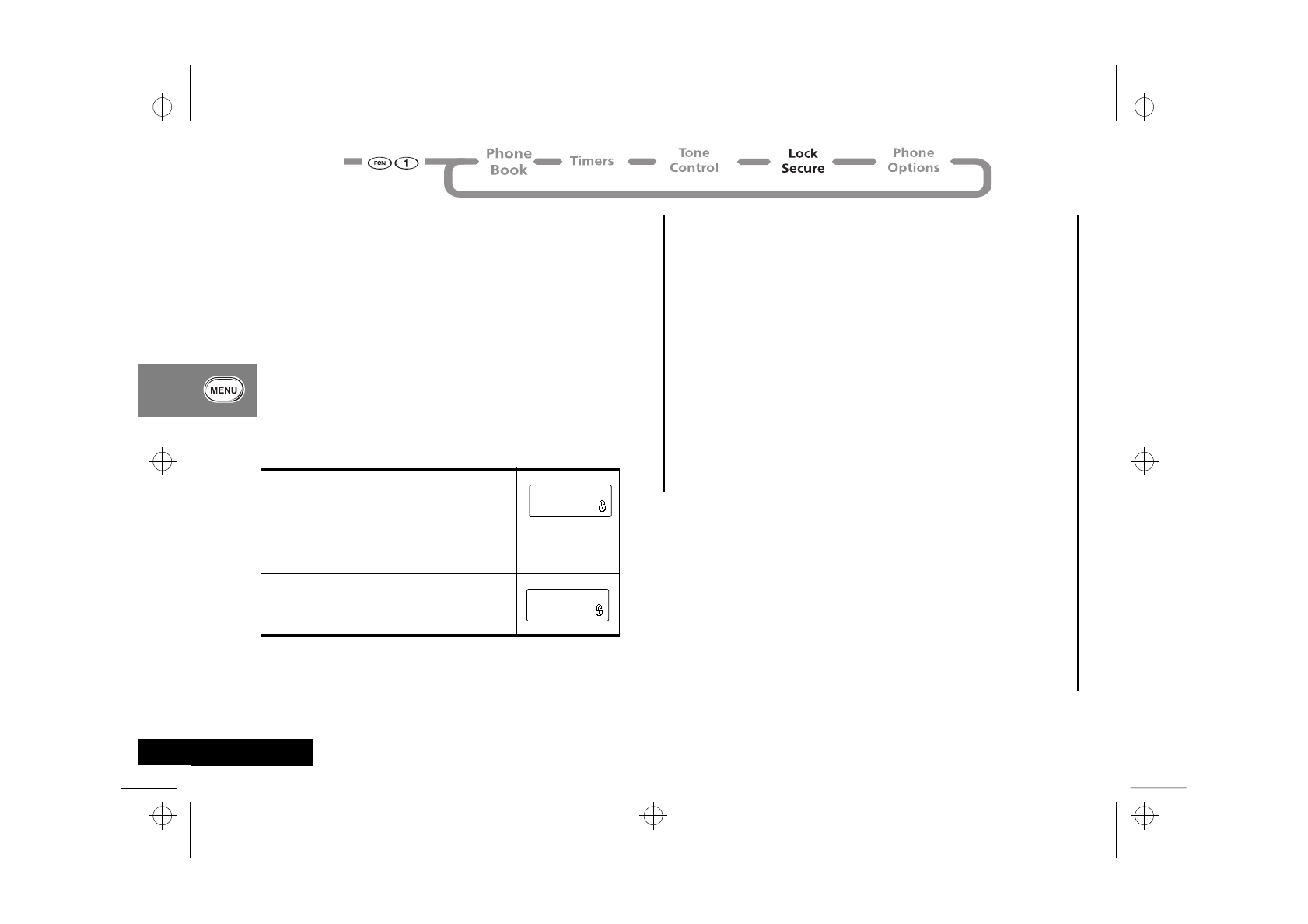
Using the Menu Features
44
English
Service Level
When loaning your phone to others, you may want to restrict call
placement or protect memory information. Your phone has two
service levels that allow you to control the types of outgoing calls
that can be made from your phone.
Your phone has two service levels:
Master Reset
Use this feature to reset all user-selectable options back to their
original factory settings.
AOnce you select this feature, the process cannot be
canceled or reversed.
Master Clear
Use Master Clear to clear all user-selectable options, the
resettable timer, the Phone Book, and the Messaging memory.
AOnce you select this feature, the process cannot be
canceled or reversed.
1Select
Feature
Press q or Z to scroll to Service Level and
press A to select.
2Choose
Level
Press q or Z to scroll through service level
settings and press A to select the setting. (See the
chart below for descriptions.)
3Exit
Menu
Press ¼ to exit the menu, or you may scroll to
other features.
Level 1: Calls can be placed from memory
locations 1-10 only.
• No dialing from keypad.
• No memory edit or storage.
• No access to name directory.
Level 4: This is the default setting.
• No restrictions.
1 Memory
1-10 Only
4 Standard
Setting
1Reset
Features
Press q or Z to scroll to Master Reset and press
A to select. You will see: Reset?
2Confirm
Reset
Press A to confirm. You will see: Standard
Setting.
or Exit Press ¼ to exit without resetting.
3Exit
Menu
Press ¼ to exit the menu, or you may scroll to
other features.
1Clear
Settings
Press q or Z to scroll to Master Clear and press
A to select. You will see: Clear?
2Confirm
Clear
Press A to confirm. You will see: Busy. It will take
a few seconds to reset all of your phone’s options
back to their factory settings.
or Exit Press ¼ to exit without resetting.
3Exit
Menu
Press ¼ to exit the menu, or you may scroll to
other features.
opt_menu.fm5 Page 44 Tuesday, October 19, 1999 10:31 PM

Using the Menu Features 45 English
Customizing Phone Options P
The Phone Options menu lets you customize the way your phone
sends and receives calls.
You can tune your phone for optimal performance, view
information about the phone, and choose from a number of
convenient features.
In this section you will learn how to:
•switch phone numbers.
•review your phone’s settings.
•select a variety of system specific settings.
Start:
Phone
Book
Timers
Lock
Secure
Tone
Control
Phone
Options
Phone
Info
Feature
Review
Call
Options
System
Options
To Main
Menu
To Main
Menu
To Main
Menu
Multi Key
Answer Off
Open To
Answer Off
Auto
Answer Off
Instant
Redial Off
Display
System ID
Select
SystemMode
Roam List
Version
Display
Options
MiniBrowser
Options To Main
Menu
Quick
Menu On
Change
Language
Change
Banner
Backlight
Select
Auto
Hyphen On
24 Hour
Clock Off
Service
Light On
Launch
MiniBrowse
Power Up
Mode
To Main
Menu
opt_menu.fm5 Page 45 Tuesday, October 19, 1999 10:31 PM
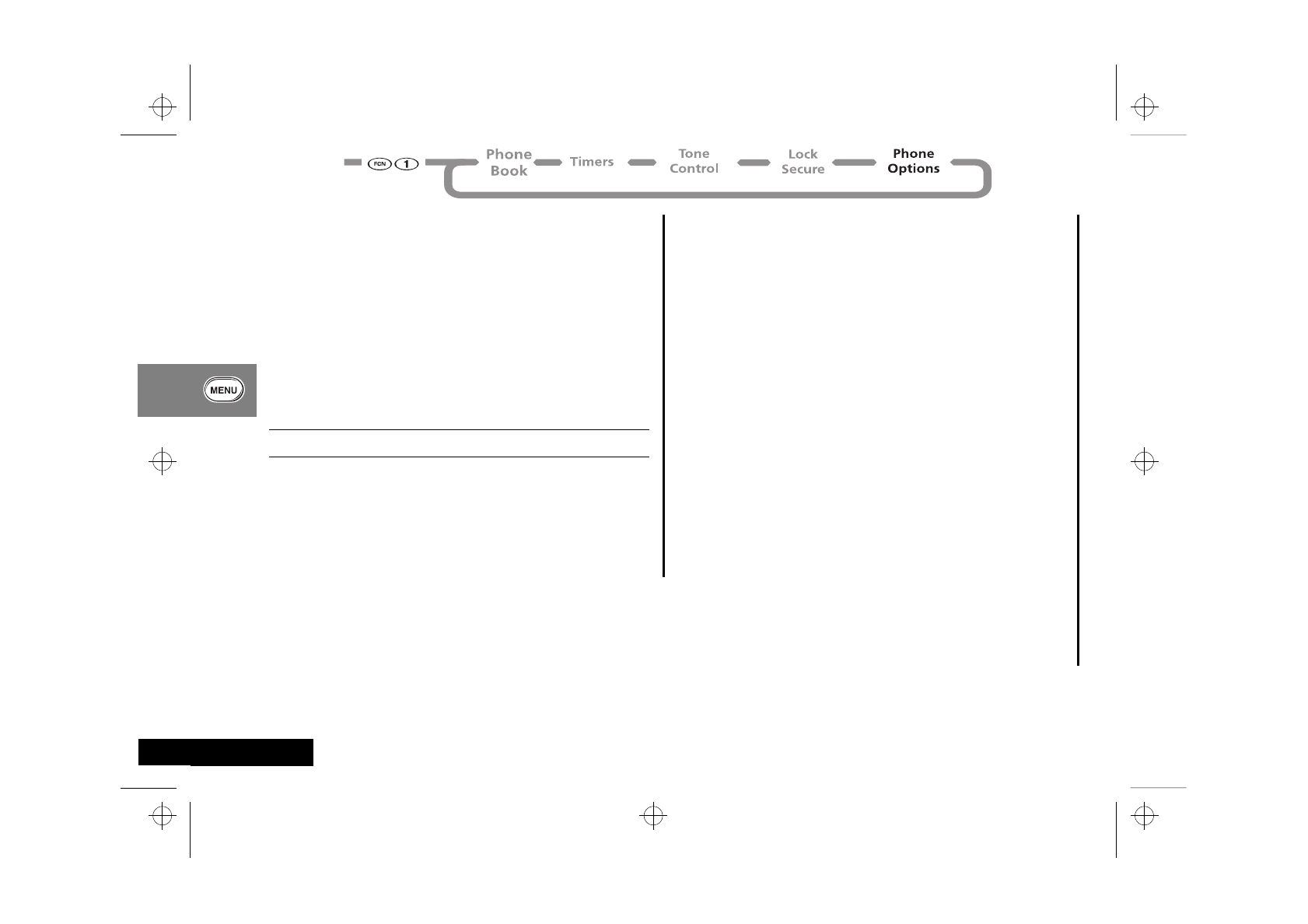
Using the Menu Features
46
English
Displaying Phone Information
This feature allows you to view information about your phone. If
you require technical assistance, you may be asked to check here.
Feature Review
iPress Ä, then 0, 9, ä.
After you have spent some time adjusting your phone’s settings,
use this feature to review the changes you have made. When you
enter Feature Review, your phone will display any features that
you have changed from their default factory settings.
AFeature Review is simply an opportunity to review – but not
change – your current settings.
Call Options Submenu
This submenu gives you control over the way your phone places
and receives calls.
Multiple Key Answer
With Multiple Key Answer ON, you can answer calls by pressing
A or any key in the center of the keypad, Ú through È.
AIf there are any digits in your Scratchpad or if your phone is
locked, this feature will not work.
1Find
Feature
Press q or Z to scroll to Phone Info then press
A to select.
2Scroll Press q or Z to scroll through the the
information.
3Exit
Menu
Press ¼ to exit the menu, or you may scroll to
other features.
1Begin
Review
Press q or Z to scroll to Feature Review and
press A to enter.
2Browse
Features
Press q or Z to scroll through any features you
have changed from their default settings. If all
features are set to their default factory settings,
the display will show: Standard Setting.
3Exit
Menu
Press ¼ to exit the menu, or you may scroll to
other features.
1Find
Feature
Press q or Z to scroll to Multi Key Answer.
2Toggle
Feature
Press A to toggle the feature On or Off.
3Exit
Menu
Press ¼ to exit the menu, or you may scroll to
other features.
opt_menu.fm5 Page 46 Tuesday, October 19, 1999 10:31 PM
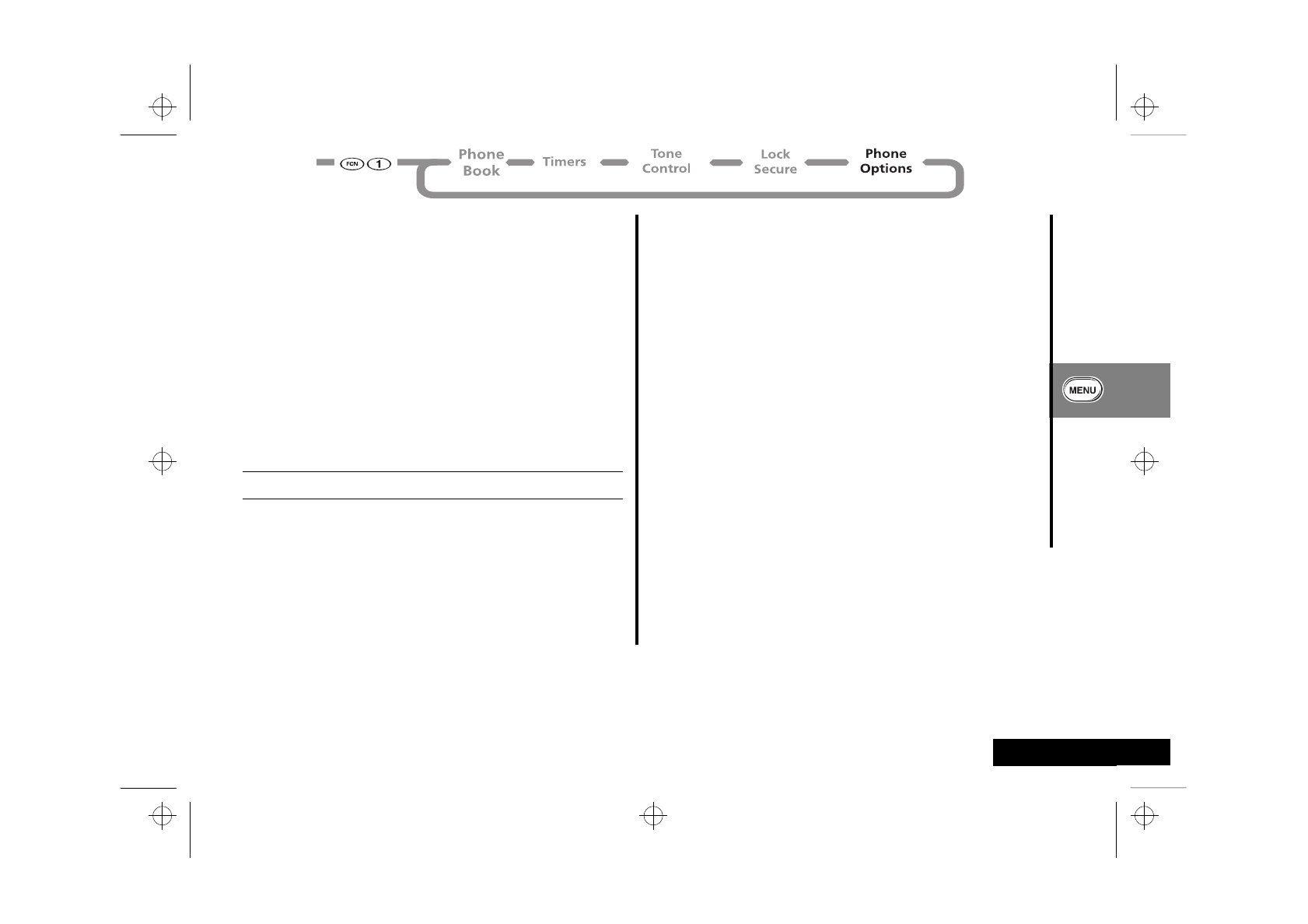
Using the Menu Features 47 English
Open to Answer
This feature allows you to set whether or not your phone
automatically answers when opened. If you subscribe to Caller
ID, you will probably want to set this feature OFF so you can open
the phone and check who is calling before you answer.
ATo answer calls with Open to Answer OFF, press ¾.
Automatic Answer
iPress Ä, a then 2, 6 and continue with step 2.
Turn Auto Answer ON to have your phone automatically answer
incoming calls after two ring cycles.
AWe recommend you use this feature only with vehicle
accessories and with your phone’s ringer active. See page
75. Otherwise, your phone may answer a call in your
absence.
Instant Redial
When placing calls, you may hear a fast busy signal and see
Press SND to Redial. This probably means the network is
temporarily busy. If you turn Instant Redial ON, your phone will
redial for the next four minutes or until the call goes through.
AThis feature redials only when the network is busy. If you
hear a normal busy signal, this feature will not work. See
page 21 for more redialing options.
1Find
Feature
Press q or Z to scroll to Open to Answer.
2Toggle
Feature
Press A to toggle the feature On or Off.
3Exit
Menu
Press ¼ to exit the menu, or you may scroll to
other features.
1Find
Feature
Press q or Z to scroll to Auto Answer.
2Toggle
Feature
Press A to toggle the feature On or Off.
3Exit
Menu
Press ¼ to exit the menu, or you may scroll to
other features.
1Find
Feature
Press q or Z to scroll to Instant Redial.
2Toggle
Feature
Press A to toggle the feature On or Off.
3Exit
Menu
Press ¼ to exit the menu, or you may scroll to
other features.
opt_menu.fm5 Page 47 Tuesday, October 19, 1999 10:31 PM
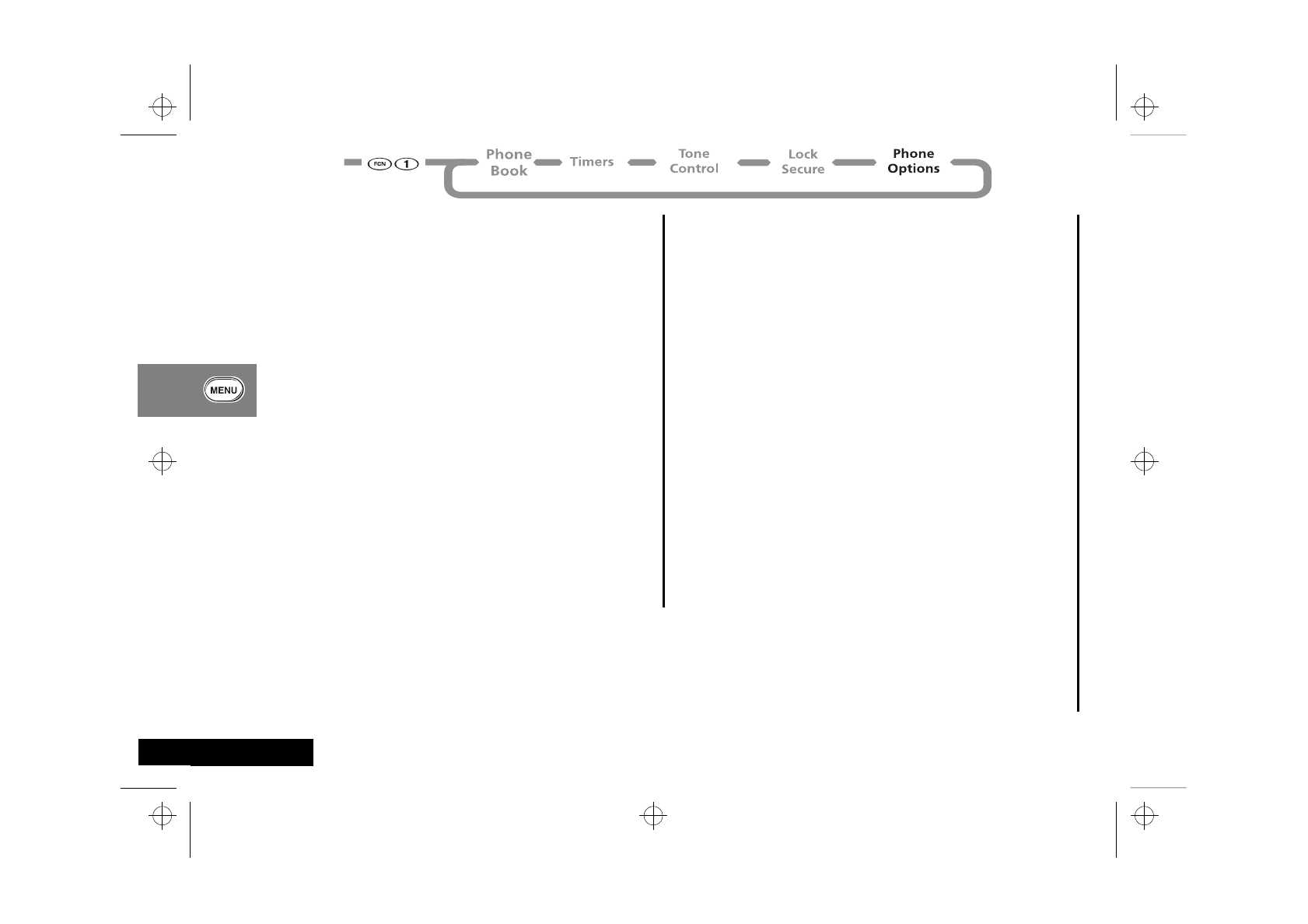
Using the Menu Features
48
English
Display Options Submenu
This submenu allows you to customize your phone’s display.
Activating the Quick Menu
Press the Smart Button once and the Quick Menu appears on the
display, offering shortcuts to the most popular features. This
feature turns the Quick Menu OFF if you would rather use the
Smart Button to go straight into the Phone Book. See page 22 for
more information.
Changing the Language
This feature allows you to select the language in the display.
Changing the Banner
You may create your own message banner for the phone to
display when it is idle. Your banner can be up to 12 characters
long.
Customizing the Backlight
Your phone’s backlight illuminates when you open the phone,
press a key, or your phone receives an incoming call signal. This
feature allows you to choose how long it remains ON.
AThe backlight will always be illuminated when your phone is
connected to an external power supply, like a charger or
vehicle accessory.
1Toggle
Feature
When you enter Display Options, you will see:
Quick Menu. Press A to toggle the feature On or
Off.
2Exit
Menu
Press ¼ to exit the menu, or you may scroll to
other features.
1Begin
Selection
Press q or Z to scroll to Change Language and
press a to select.
2Choose
Option
Press q or Z to scroll through the available
languages and press a to select.
3Exit
Menu
Press ¼ to exit the menu, or you may scroll to
other features.
1Enter
Feature
Press q or Z to scroll to Change Banner and
press a to select. You will see the current banner
or Alpha or Press §.
2Enter
Message
Enter your message using the alphanumeric
keypad. Press A when your message is complete.
3Exit
Menu
Press ¼ to exit the menu, or you may scroll to
other features.
1Find
Feature
Press q or Z to scroll to Backlight Select and
press A to select.
2Toggle
Feature
Press q or Z to scroll to Backlight 15
Seconds, Backlight 30 Seconds, or
Backlight Always On and press A to select
the displayed option.
3Exit
Menu
Press ¼ to exit the menu, or you may scroll to
other features.
opt_menu.fm5 Page 48 Tuesday, October 19, 1999 10:31 PM

Using the Menu Features 49 English
Auto Hyphen
Just turn Auto Hyphen ON to have all phone numbers
automatically hyphenated on the display. This allows you to easily
distinguish between area codes, call prefixes, and other numbers.
Displaying the 24-Hour Clock
Your phone can display the current time in 12-hour or 24-hour
format. Use this feature to turn the 24-hour clock On or Off.
MiniBrowser Options*
This submenu offers several options for customizing the way your
phone accesses information with the MiniBrowser.
Launching the MiniBrowser
Select this feature to launch the MiniBrowser and access sports
scores, stock reports, weather reports, and more.
AYou can also launch the MiniBrowser with the Quick Menu.
See page 22.
Power Up Mode
When you turn ON your phone, you can begin with the
MiniBrowser or the regular phone features.
* Contact your Service Provider for availability.
1Find
Feature
Press q or Z to scroll to Auto Hyphen.
2Toggle
Feature
Press A to toggle the feature On or Off.
3Exit
Menu
Press ¼ to exit the menu, or you may scroll to
other features.
1Find
Feature
Press q or Z to scroll to 24 Hour Clock.
2Toggle
Feature
Press A to toggle the feature On or Off.
3Exit
Menu
Press ¼ to exit the menu, or you may scroll to
other features.
1Find
Feature
Press q or Z to scroll to Launch MiniBrowser.
2Select Press and hold A to select.
3Exit
Menu
Press ¼ to exit the menu, or you may scroll to
other features.
1Find
Feature
Press q or Z to scroll to Power Up Mode. and
press A to select.
2Select
Option
Press q or Z to scroll to Power Up Phone or
Power Up MiniBrowse and press A to select.
3Exit
Menu
Press ¼ to exit the menu, or you may scroll to
other features.
opt_menu.fm5 Page 49 Tuesday, October 19, 1999 10:31 PM
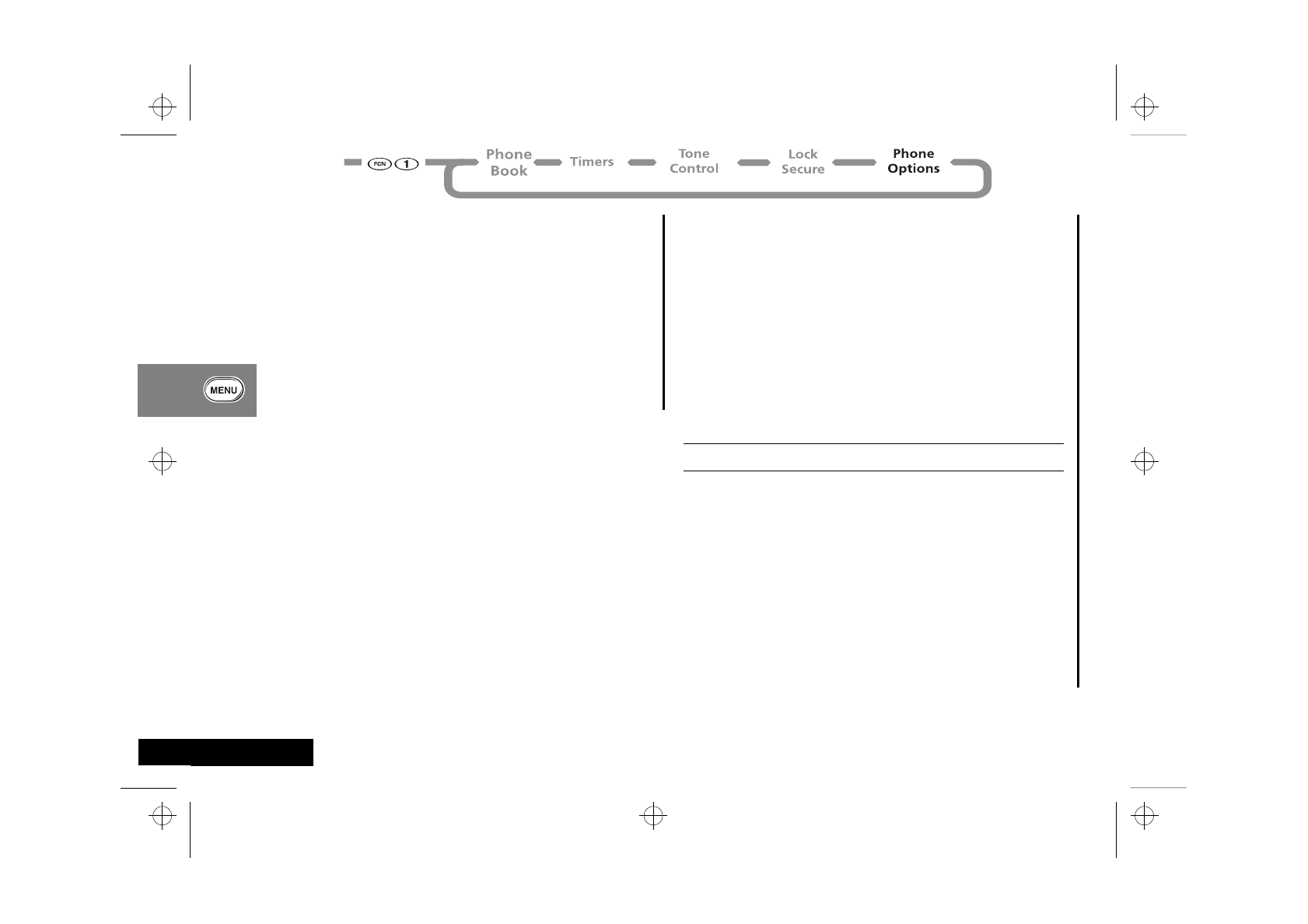
Using the Menu Features
50
English
Confirm at Start-up
Your phone can display reminders when you launch the
MiniBrowser to indicate that your time browsing may be
charged. This feature toggles the reminder ON or OFF.
System Options Submenu
The System Options submenu offers a couple features that will
help you use your phone and wireless network.
Displaying the System ID
Use this feature to determine the unique System ID for your
wireless phone.
Selecting a System Mode
iPress ä then Ç and continue with step 2.
Your Service Provider configures Select System Mode when you
receive your phone. This feature allows you to select the type of
system your phone will attempt to access. See below for a chart of
available settings.
1Find
Feature
Press q or Z to scroll to Confirm at Start.
2Toggle Press A to toggle between On and Off.
3Exit
Menu
Press ¼ to exit the menu, or you may scroll to
other features.
1View SID Press A to select Display System ID. You will
see the System ID for your phone.
2Exit
Menu
Press ¼ to exit the menu, or you may scroll to
other features.
1Begin
Selection
Press q or Z to scroll to Select SystemMode and
press a to enter. The display will show your
phone’s current System Mode setting.
2Choose
Mode
Press q or Z to scroll through the System Mode
settings (see chart on next page). Press a to select
the displayed setting.
3Exit
Menu
Press ¼ to exit the menu, or you may scroll to
other features.
opt_menu.fm5 Page 50 Tuesday, October 19, 1999 10:31 PM

Using the Menu Features 51 English
Displaying the Roam List Version
This feature displays the Roam List Version used by your phone. If
you require technical assistance, you may be asked to check this
feature.
Standard Mode:
Your phone first seeks a home type system, then a
non-home type system.
Home Only Mode:
Phone will not operate outside its home system.
1View Roam
List
Press q or Z to scroll to Roam List Version
then press A to select. You will see: Version
XXXX.
2Exit
Menu
Press ¼ to exit the menu, or you may scroll to
other features.
Standard
Scan
Home
Only
opt_menu.fm5 Page 51 Tuesday, October 19, 1999 10:31 PM

Using the Menu Features
52
English
opt_menu.fm5 Page 52 Tuesday, October 19, 1999 10:31 PM

Using the Messaging Menu 53 English
Using the Messaging Menu*
The dedicated Message Key provides access to your phone’s new
and easy Messaging Menu. Through this menu, you can check
your Voice Mail, read your pager-like alphanumeric Messages,
access MiniBrowser alerts, and view the Caller IDs of your most
recent callers.
In this section you will learn how to:
•view your Caller IDs.
•check your Voice Mail.
•read your Messages.
•explore your options with the Function Menus.
Receiving Messages
If your phone is ON and you receive a Voice Mail, MiniBrowser
alert, or alphanumeric message: an indicator appears on the
display:
•o Appears on the lower line of the display when you receive
an alphanumeric message. It will stay on the display until you
have read the message.
•Urgent o Appears in the main display when you receive an
urgent message and your phone is in idle mode. After a few
seconds, the screen will change to Press o and begin
flashing.
•Msg Mem Low Appears when your phone’s message memory is
almost full (at approximately 85% capacity).
* Contact your Service Provider for availability.
Your Service Provider holds your messages and will forward
them after you have made room. See page 60 to learn how to
delete messages.
•Msg Mem Full Appears in the main display when the message
memory is completely full and your phone is in idle mode.
AYour Service Provider holds your messages and will forward
them after you have made room. See page 57 to learn how
to delete messages.
•p Appears on the lowe line of the display when you receive
a Voice Mail message. It will stay on the display until you have
listened to the message. Your Service Provider will then signal
your phone to turn the indicator OFF.
AFor information on MiniBrowser alerts, see page106.
Press ¿ to open the Messaging Menu:
When you open the Messaging Menu, the icon of the message
type you received will be flashing.
2512
Voice Mail
Messages
Caller ID
MiniBrowse Alrt
Voice Mail Indicator
Message Indicator
msg.fm5 Page 53 Tuesday, October 19, 1999 10:37 PM

Using the Messaging Menu
54
English
Viewing Your Caller IDs
AContact your Service Provider for availability.
Your phone supports Caller ID service, which lets you see who is
calling before you answer. The Caller IDs for the last 16 different
callers are stored so they can be viewed at any time.
You will see a Caller ID icon
for each stored Caller ID. Flashing
icons represent Caller IDs that have not been viewed. Below the
icons you will see information for the latest Caller ID:
Keep in mind: You will see the caller’s name only if it is stored in
your Phone Book.
y A check mark will appear in the corner if you have answered or
returned the call. Press ¾ to return the call of the displayed
caller. Press Â
to store the information.
Caller ID Options
When viewing Caller IDs, press the Message Key to see the
options available for the highlighted Caller ID.
1Enter
Messaging
Press ¿ to open the Messaging Menu.
2Select
Caller ID
Press q
or Z
to scroll to Caller ID and press a to
select.
3Select Caller Press q
or Z
to highlight a Caller ID to view and
press a
to view complete information for that
call:
2512
12:10pm 08/02/9
9
1-312-555-121
2
selected Caller ID
time & date of call
your caller‘s
phone number
2512
Smith J
Home
1-312-555-121
2
02
number
of times
they called your caller’s phone
number
your caller’s
name
1Enter
Messaging
Press ¿ to open the Messaging Menu.
2Choose
Function
Press q
or Z
to scroll to one of the following:
2512
Exit
Store To Memory
Call Back
Go To
Messaging
Menu Exit
Delete
Message
Delete All
Messages
msg.fm5 Page 54 Tuesday, October 19, 1999 10:37 PM
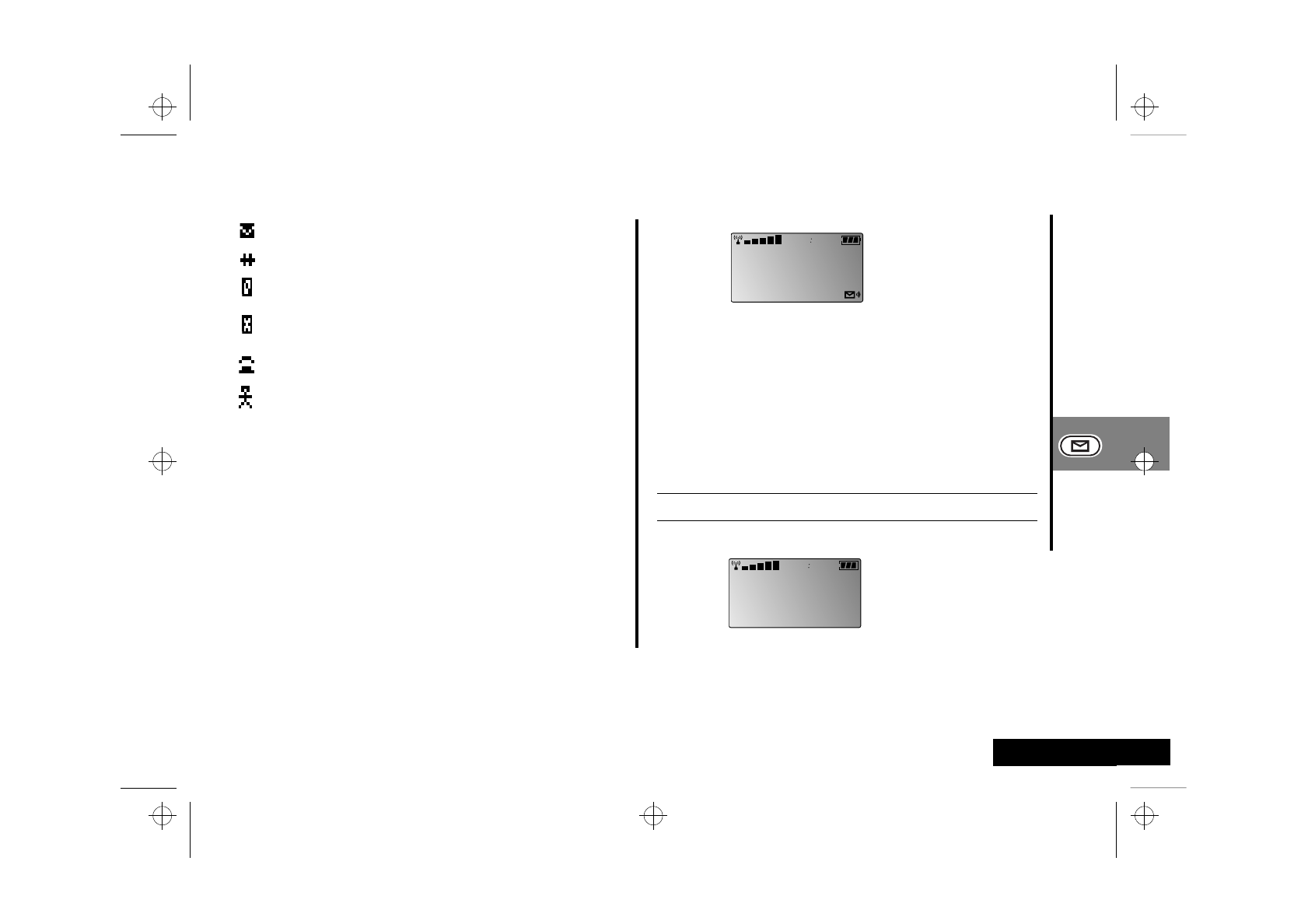
Using the Messaging Menu 55 English
Checking Your Voice Mail
AContact your Service Provider for availability.
When you receive Voice Mail, your Service Provider sends a
notification to your phone and your phone displays an indicator.
That way, you will be able to check for new Voice Mail simply by
glancing at your phone’s display.
If you have one or more Voice Mail messages, you will see:
To listen to your messages, dial your access number. Your phone will
do this automatically with one key press.
See the following page for more options.
ASome Service Providers send the Voice Mailbox number to
your phone automatically. If the number has not been sent,
then store it in location 98 of your Phone Book. To learn
how, see Pause Dialing on page 26.
iPress and hold ¿ to call your Voice Mail number.
If you have no new messages, you will see:
Go To Msg
Menu
Press a
to return your phone to the
Messaging Menu.
Exit Press a
to exit Messaging to idle mode.
Delete
Message
Press a
to delete the currently selected Caller ID.
Press a
again to confirm.
Delete
AllMsgs
Press a
to delete all your Caller IDs.
Press a
again to confirm.
CallBack Press a
to return the call.
Store To
Mem
Press a
to begin storing the number. Enter a
two-digit location, select a label, enter a name,
and press Â
again.
1Enter
Messaging
Press ¿
to open the Messaging Menu.
2Select
Voice Mail
Press q
or Z
to scroll to Voice Mail and press a
to select.
Dial
Number
When viewing notifications, press ¾
or press
and hold a
to call your Voice Mail box.
2512
Voice Mail
You Have
2512
Voice Mail
No
msg.fm5 Page 55 Tuesday, October 19, 1999 10:37 PM
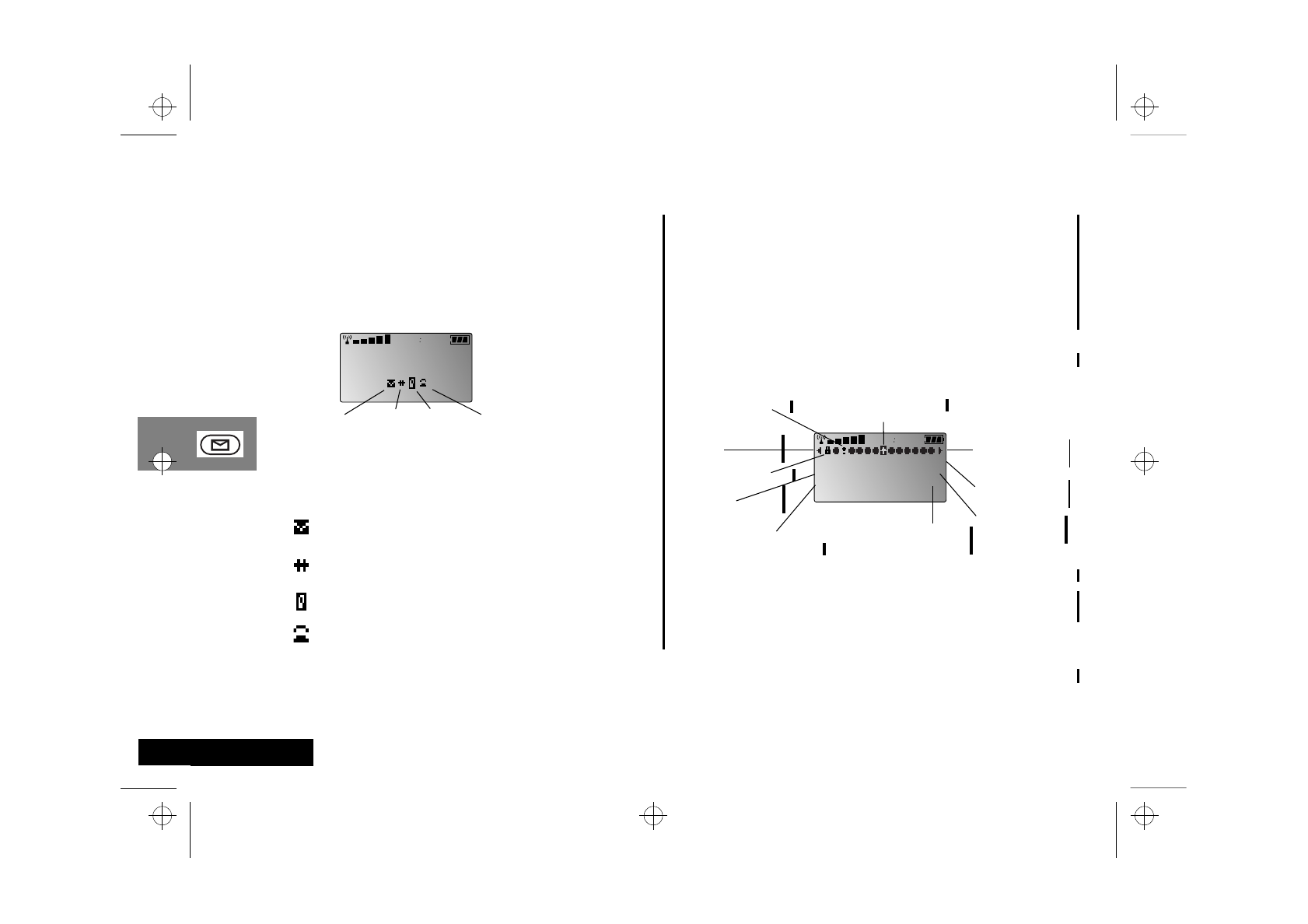
Using the Messaging Menu
56
English
Voice Mail Options
When checking Voice Mail, press the Message Key to see options
for the highlighted Voice Mail notification.
Reading Your Messages
AContact your Service Provider for availability.
Your phone can receive alphanumeric messages like a pager. The
message memory stores up to 60 messages, depending on the
size of each.
3Access
Options
Press ¿ to open the Voice Mail Function
Menu.
4Choose
Function
Press q
or Z
to scroll to one of the following:
Go To Msg
Menu
Press a
to return your phone to the Messaging
Menu.
Exit Press a
to exit Messaging to idle mode.
Delete
Message Press a
to delete the currently selected Voice
Mail notification. Press a
to confirm.
CallBack Press a
to dial your Voice Mail box number.
2512
Exit
Call Back
Go To
Messaging
Menu
Exit Delete
Message
1Enter
Messaging
Press ¿ to open the Messaging Menu.
2Select
Messages
Press q
or Z
to scroll to Messages and press a
to select.
Flashing icons represent messages that have not been viewed.
Select a
Message
Press q
or Z
to highlight a message to read and
press a
to select the message.
Once a message is selected, the following keys will help you
read through your messages:
Scroll Press a
or Z
to scroll through the selected
message.
2512
M: Happy B-day!
1: F:8475551212
12:34pm 07/07/99
selected message
more messages
(right)
time and date
of message
text of
message
more messages
(left)
urgent message
locked message
sender’s
number
more
text
message
number
msg.fm5 Page 56 Tuesday, October 19, 1999 10:37 PM

Using the Messaging Menu 57 English
Message Options
When reading your messages, press the Message Key to see the
options available for the highlighted message.
Previous
Message
Press q
or Ç to go to the previous message.
Next
Message
Press È
to go to the next message.
If the message includes a number in parentheses (a Call Back
number) you can use the following shortcuts:
Call Back Press ¾
to dial the Call Back number (in
parentheses if included).
If the Call Back number matches one in your
Phone book, you will see the name of the caller
when you view the message.
Store Press Â
to store the Call Back number (in
parentheses if included) in your Phone Book.
3Access
Options
Press ¿
to open the Message Function
Menu.
2512
Exit
Store To Memory
Call Back
Go To
Messaging
Menu Exit
Delete
Message
Delete All
Messages
Lock
(Unlock)
4Choose
Function
Press q
or Z
to scroll to one of the following:
Go To Msg
Menu
Press a
to return your phone to the Messaging
Menu.
Exit Press a
to exit Messaging to idle mode.
Delete
Message
Press a
to delete the currently selected
message. Press a
again to confirm.
Delete
AllMsgs
Press a
to delete all messages. Press a
again to
confirm.
Lock
Message
Press a
to lock or unlock the message. Lock
important messages to protect them from
accidental deletion.
Unlock
Message
Messages must be unlocked before they can be
deleted.
If the message contains a Call Back number
(in parentheses), you will also see these options:
CallBack Press a
to dial the sender’s number.
Store To
Mem
Press a
to begin storing the number. Enter a
two-digit location, select a label, enter a name,
and press Â
again.
msg.fm5 Page 57 Tuesday, October 19, 1999 10:37 PM

Using the Messaging Menu
58
English
msg.fm5 Page 58 Tuesday, October 19, 1999 10:37 PM
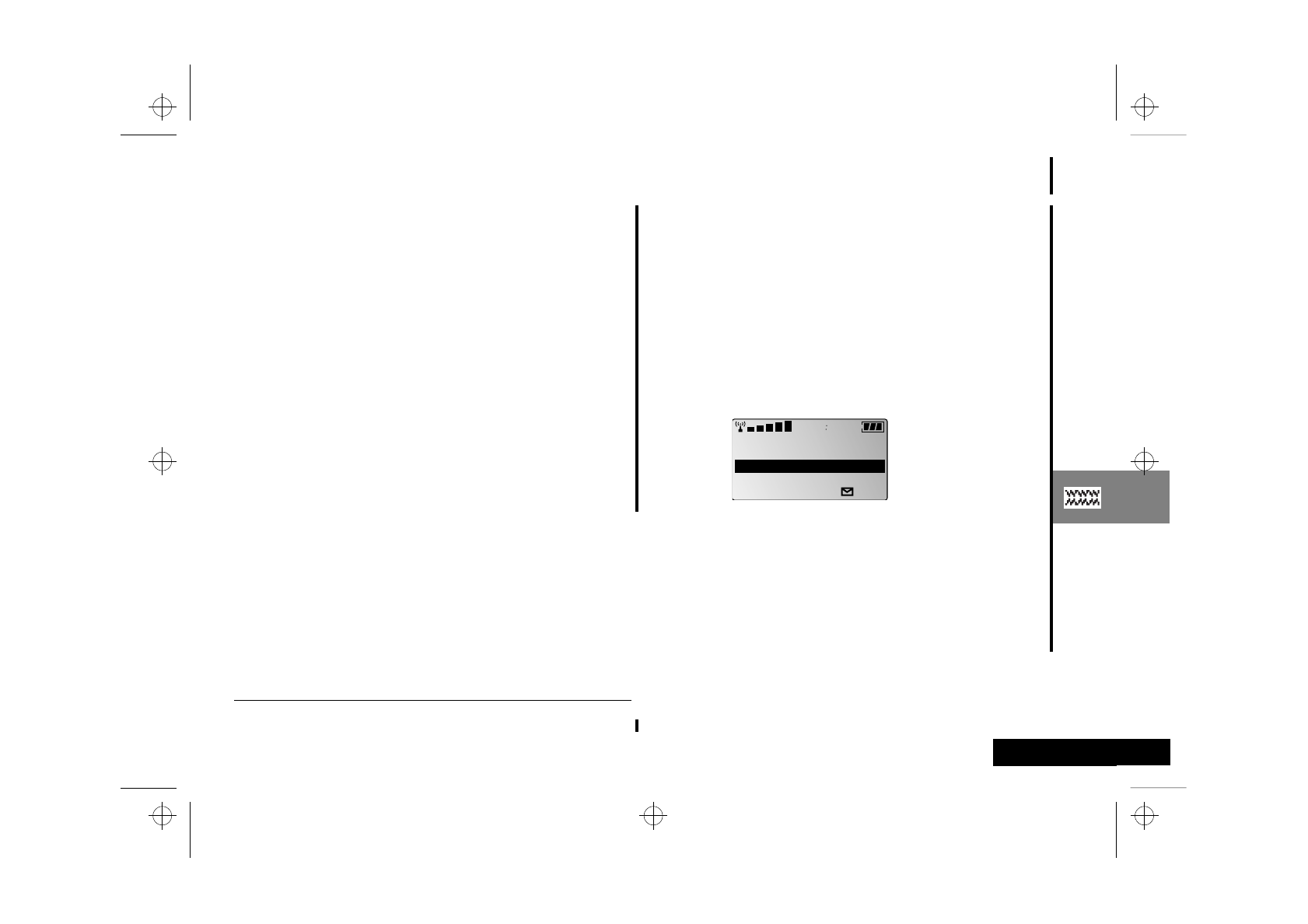
Using the MiniBrowser 59 English
Using the MiniBrowser*
Your phone can give you instant access to valuable resources.
With a subscription and wireless service, you can retrieve sports
scores, weather and traffic reports, stock prices, and more.
In this section you will learn how to:
•launch the MiniBrowser.
•navigate using your phone.
•bookmark your favorite sites
Follow these symbols as a guide for using the MiniBrowser.
Press q to scroll up.
Press Z to scroll down.
Press ä for Soft Key
Press  for Soft Key
Press C to go back or stop, hold to return to home page
Press ¼ to exit
* Contact your Service Provider for availability.
Getting Started Browsing
To get started with you MiniBrowser, you will need an IP address
for your phone. The IP address is the location of a server provided
by your Service Provider, and it will be loaded into your phone by
your Service Provider when you subscribe to this service. Contact
your Service Provider for more information.
Launching the MiniBrowser
If your IP address is already set, then you are ready to go.
Just follow these simple steps:
For more setup options and another way to launch the browser,
turn to page 49.
1Open
Quick Menu
Press a to open the Quick Menu.
2Select
Browser
Press q or Z to scroll to Launch Browser and press
a to select.
When you launch the MiniBrowser, you will see
the last page you accessed with the MiniBrowser.
If this is your first time, you will see your home
page.
2512
Messaging
Last 10 Dialed
Phone Book
Launch Browser
browse.fm5 Page 59 Tuesday, October 19, 1999 10:45 PM

Using the MiniBrowser
60
English
MiniBrowser Navigation
If you know the keys to navigate your phone’s other features,
then you already have a head start at navigating with the
MiniBrowser.
Scrolling and Selecting
When browsing, you will see a list of options on the phone’s
display. Each of the items on the list is assigned a number. Just
press the matching numeric key to select that item. Or you can
scroll to the item with the volume keys and use the Smart Button
to select.
MiniBrowser Navigation
Soft Keys
In addition to the familiar keys for scrolling and selecting, the
MiniBrowser makes uses of “soft keys.” Soft keys are keys that
change their function according to the screen. Read the lower
line of the display (above the indicators) to find out what the soft
keys can do on that screen.
You will see two functions, one on the left and one on the right,
each with an icon:
Select
Item
Press the key matching the number of the list
item. In the above example, press à for Email.
Scroll Press q or z to scroll up and down the page. You
can also use Ç or È. Above, press z once
to scroll to Email, twice to scroll to To-Do List.
Select Press a or the left soft key (see the next page) to
select the highlighted item. Above, press a to
select Web Sites.
Go Back
One Page
While navigating, press C to return to the
previous page.
Stop When sending and receiving data, press C to
interrupt transmission.
2512
7 EMail
8 To-Do List
6 Web Sites
OK Inbox
Scroll bar (more
options up and
down)
Options
Return to
Home
Press and hold C to return to your home page.
Left
Soft Key
Press ä to choose the option on the left. In the
above example, press ä to select OK and
accept the highlighted option: Web Sites
You can also press a to select the left option.
Right
Soft Key
Press  to choose the option on the right. In
the above example, press  to select Inbox.
Press ä
for left soft key
2512
7 EMail
8 To-Do List
6 Web Sites
OK Inbox
Press Â
for right soft key
browse.fm5 Page 60 Tuesday, October 19, 1999 10:45 PM

Using the MiniBrowser 61 English
Display Messages
While you navigate, the lower line of the display will show you
messages to let you know what your phone is doing. You will
see: Sending))))), Receiving(((((, or Waiting.....
Bookmarks
Bookmarks make it easy to quickly jump to the sites you use most
often. You can assign up to nine bookmarks, one for each of the
numeric keys on the keypad. See page 62 to learn how to make a
bookmark. Once you bookmark the site, press and hold the key
and you will automatically jump to the page.
ABookmarks are only available while browsing.
MiniBrowser Alerts
To stay current with changing information, like stock prices or
sports scores, you can subscribe to MiniBrowser alerts through
your Service Provider.
If your phone is ON and you receive a MiniBrowser alert:
•An alert sounds: Your phone will beep three times.
See Setup Message Tones on page 39 to set your phone’s
alert. See page 39 to learn about Reminder Tones.
•An indicator appears: o Appears on the lower line of the
display. It will stay on the display until you have checked the
alert.
Receiving Calls
Most of the time, while browsing you will not be able to receive
calls (depending on your service, callers will probably get your
Voice Mail).
ALook for the IU indicator on the lower line of the display. If
you see it, your phone is online and you will not be able to
receive calls.
Occasionally, when you access a page that you have recently
visited and the information on the page has not changed, your
phone may use a version of the page stored in its memory. When
this is the case and you receive a call, your phone’s alerts will
sound and the display will show the Caller ID (if available).
Entering Words
At times you may need to enter information while browsing, like
a keyword for searching or a message. If you see a flashing
cursor, you can use the keypad to enter letters and punctuation
in the same way you do for the internal Phone Book. See page 24
for more information.
1Check
Message
Press ¿ to open the messaging menu. The
icon of the message type received will be flashing.
2Select Alert Press q or z to scroll to MiniBrowse Alrt and press
a to select.
Answer
Call
Press ¾ to answer the call. Your browsing
session will be put on hold while the call lasts.
Once the call is complete, your phone will return
to the same site.
browse.fm5 Page 61 Tuesday, October 19, 1999 10:45 PM

Using the MiniBrowser
62
English
Security
To find out if the information you are sending is secure, just look
at the lower line of the display. A key icon denotes a secure
transmission. If the key has a slash through it, then the
transmission is not secure.
The MiniBrowser Menu
Through this menu, you can set Bookmarks, read MiniBrowser
alerts, refresh the display, and other advanced features.
AThis menu is only available while browsing.
Help
If you need assistance while browsing, select this option.
ASome sites do not have help available.
Home
Select this option to return to the home page set up by your
Service Provider.
Mark Site
To add a page to your bookmark list, choose this feature. Once
bookmarked, press and hold the corresponding key to jump to
the bookmarked page. There are nine bookmarks available so
your favorites are never more than a keypress away.
Show URL
To see the address of the current page, choose this feature.
Reset UP
This features relaunches the MiniBrowser.
About UP
This feature offers information on the company that helps to
provide the web browsing service.
Select Press a to select Help. You will see a help screen
specific to the site.
Select Press a to select Home. You will see the home
screen of your Service Provider.
Secure Non-Secure
1Select Press a to select Mark Site. You will see: Select
Number.
2Select
Number
Press a key, Ú through á, to choose the
bookmark number.
Select Press a to select Show URL. You will see the
address of the current page.
Refresh
Display
Press a to select Reset UP. You will see the start-up
screen and then the first menu.
View
Page
Press a to select About UP. You will see a page
with information.
browse.fm5 Page 62 Tuesday, October 19, 1999 10:45 PM

Using the MiniBrowser 63 English
Advanced Settings
This submenu contains a couple features for advanced users, like
security and technical settings.
1Select Press a to select Advanced.
2Scroll Press q or z to scroll to Set.UP Link or
Security and press a to select.
browse.fm5 Page 63 Tuesday, October 19, 1999 10:45 PM

Using the MiniBrowser
64
English
browse.fm5 Page 64 Tuesday, October 19, 1999 10:45 PM

Accessories 65 English
Accessories
The following accessories have been designed to work with your
phone. Additional accessories may be available and are packaged
separately. Please refer to your local service provider or retail
outlet for more information.
Vehicular Power Adapter
The Vehicular Power Adapter connects to your phone and allows
you to charge your phone's battery while driving. When the
phone is in use, the adapter overrides the battery therefore
preserving battery life. The adapter also provides dead battery
operation.
AIn some cars, the engine must be running in order for the
Vehicular Power Adapter to operate.
Personal Handsfree System
The convenient headset provides both an earphone and
microphone for simple handsfree and private telephone
conversations. The headset plugs directly into the jack on the top
of your phone, so that you can wear your phone and move
freely. Place the foam cover on the earpiece for a more
comfortable fit..
Zero Install Car Kit
For the quickest and easiest mobile solution, use the Zero Install
Car Kit. Just plug it in, attach the microphone, and you are ready
to go.
Accessory Limited Warranty Information
We recommend that you use Motorola original batteries and
accessories. Under its limited cellular telephone warranty,
Motorola specifically disclaims any responsibility for damage
caused by the use of portable cellular telephone accessories not
manufactured by Motorola.
For details on the complete line of Motorola cellular accessories,
see your dealer or visit our Web site at
http://www.mot.com/
m3cd_us.bk : access.fm5 Page 65 Tuesday, October 19, 1999 10:47 PM

Accessories
66
English
m3cd_us.bk : access.fm5 Page 66 Tuesday, October 19, 1999 10:47 PM
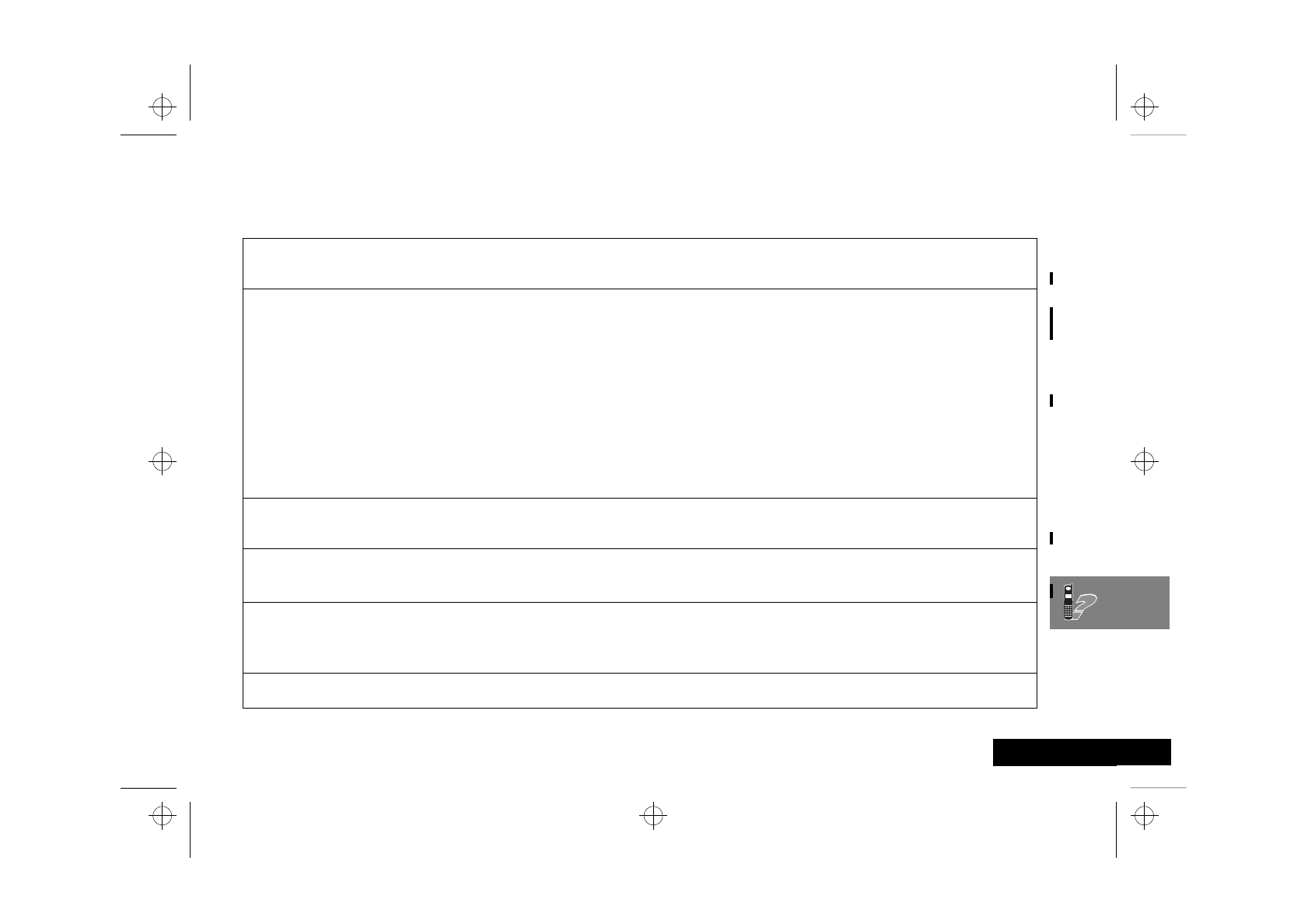
What to do if... 67 English
What to do if...
I pressed the power button, but
nothing happened. What’s
wrong with my phone?
Make sure that you press and hold the power button until the display appears and you hear an audible
alert. If nothing still happens, then check that you have installed a battery and that the battery is charged.
For more information about batteries and charging see “Your Battery” on page 15.
My battery didn’t last as long as
I expected. What can I do to
extend battery life?
Your battery’s “talk-time” and “standby-time” are relative measurements of the battery’s capacity. The
more you talk on the phone, the less standby-time you have, and vice versa.
You can also turn on the Power Save Mode feature to extend battery life. However, the LED Power/Status
Indicator does not light when this feature is activated.
Certain features demand power from your battery and reduce battery life. If you have selected the
Automatic Display of Individual Call Timer feature, the display uses battery power to remain active during
each call. Turn this feature off to conserve battery energy. (See “Auto Display Individual Timer” on page 36
for more information on this feature.)
Make sure that you are using batteries that are compatible with your phone.
Exposing your battery to extreme temperatures—below -10°C (14°F) or above 45°C (113°F)—can shorten
battery life. Batteries are especially sensitive to high temperature extremes. As a good rule, always take your
phone with you when you leave your car.
The display says, “Locked.” How
do I unlock my phone?
Enter the last three digits of your cellular number. If that doesn’t work, use the factory preset lock code:
123. If all else fails, call your service provider (the company that sends you your monthly cellular bill) for
assistance. (See “Using Lock/Security Features” on page 41 for more information on Security Features.)
I tried to place a call and
received a fast busy signal.
This sound means that the cellular system did not process your call. For example, the cellular system may be
overloaded with call attempts. To redial the number, press ¾ before ending your call attempt, or press
¼ and try the call again later. (See “Redialing a Number” on page 21 for more information on redialing.)
I tried to place a call and
received an alternating high/
low tone.
This sound means your call did not reach the cellular system. You may have dialed the number too soon
after turning the phone on. Wait until the “NS” light stops blinking before placing a call.
An alternating tone may also indicate that your phone’s signal is blocked. Make sure the antenna is fully
extended and you’re clear of any obstructions such as bridges, parking garages, or tall buildings.
My phone was stolen. What
should I report and to whom?
Report a stolen phone to the police and to your service provider (the company that sends you your monthly
cellular service bills).
m3cd_us.bk : notes.fm5 Page 67 Tuesday, October 19, 1999 10:47 PM

What to do if...
68
English
I tried to listen to my Voice Mail
(or use a paging service, a
calling card, etc.) but nothing
happened.
You have probably turned off the transmit tones. Place your call, enter the access numbers when prompted
by the recording, then press ä ¾. To avoid this problem in the future, follow the directions in
“Transmit Tones” on page 40 to turn the transmit tones on.
I tried to place a calling card call
using the internal Phone Book,
but it didn’t work.
You may have turned off your transmit tones. Follow the directions in “Transmit Tones” on page 40 to turn
the transmit tones on.
Check that you stored your calling card information in the correct order, and make sure the groups of
numbers are separated by pauses. The easiest way to correct the sequence may be to start from scratch.
Follow the instructions on “Storing Calling Card Numbers” on page 27, enter your calling card information
again, and store it in the same memory location as your previous attempt.
Also keep in mind that when using your calling card, you must enter the number you are calling with the
area code, but without the initial “1.” Check with your long distance carrier for details on using your calling
card.
My phone started beeping, and
the display says: 1 Call
Unanswered. What happened?
Someone tried to call you while you were in an area where the signal was weak. Press C to clear your
display, extend your phone’s antenna, and avoid obstructions like tunnels, parking garages and tall
buildings whenever possible.
I launched the MiniBrowser but
the display says: Service Not
Available. What is wrong?
You are in an area without service. If you have wireless service, look in the display for the Digital indicator. If
you don’t see it you may have only Analog service or no service at all. If you do see the Digital indicator, you
may be connected to digital network that does not support Internet access.
I launched the MiniBrowser but
the display says: Data Server
Unavailable. What is wrong?
Try again in a few minutes. The servers may be temporarily busy.
m3cd_us.bk : notes.fm5 Page 68 Tuesday, October 19, 1999 10:47 PM

Patent Information 69 English
Patent Information
Manufactured under one or more of the following patents:
4121218 4127824 4128740 4138681 4193036 4254382
4302845 4312074 4327319 4329666 4369516 4369522
4378603 4390963 4398265 4400584 Re.31470 4431977
4434461 4455534 4462098 4484153 4485486 4486624
4491972 4504834 D278708 4523155 4546329 4549311
4550426 4551696 4564821 D282169 4571595 4573017
4574243 4585957 4602218 D284759 4616314 4617520
4626309 4628529 4629829 4630304 4630305 4633141
4636593 4636741 4644351 D288432 4648125 4649543
D288683 4654655 4654867 4662691 4667333 4668917
4670747 4672502 4692726 4704588 D292578 4706036
D292920 4710724 4711361 4715063 4716319 4716391
4723305 D294257 4727306 4727583 4730195 4734635
4737976 4740794 4741018 4741034 4742562 D295627
D295975 4751737 4761621 4764737 D297734 D297735
D297736 4777564 Re.32768 4783697 D299232 4797929
4798975 4800348 4802236 4803726 4809356 4811377
4811404 4816774 4817157 4823098 D300742 D300827
4827226 4827507 4829274 4829543 4837534 4843621
4845772 4851966 4868576 4872196 4873683 4876552
4876740 D304189 4879533 4885553 4887050 4890199
D305427 4896124 4896361 4897873 D305717 4903327
D306163 4904549 4905288 4905301 D306299 4910470
4912602 4916262 4918403 4918732 4922209 4924194
4930126 D309301 D309451 4945570 4954796 4956854
4963812 4963843 4965537 4970475 4972355 4972432
4972455 4975808 4982108 4984219 4989230 D314173
4992753 4998289 D315330 D315543 5004992 5008925
5010309 5010570 5014294 5014346 D316859 5017856
5018188 5020076 5020091 5020092 5020093 5023580
5023866 5023911 5025387 5028859 5029233 5036532
5040127 5042071 5045824 5053924 5055800 5055802
5055803 5057762 5058136 5059885 5060264 5060294
5063340 5065408 5067139 5068625 5070310 5077757
5081674 5083304 5093632 D325028 5107487 5109536
5111162 5113400 5113436 5117441 5117449 5121047
5121288 5121412 5122722 D327062 5124889 5127040
5127042 5128834 5130682 5130683 5133010 5136135
5140286 5142551 5142696 5148471 5150075 5150359
5150384 5152006 5152007 5153590 5157693 5159283
5160898 5163159 5164652 5166596 5166642 5170173
5170492 5173672 5175759 5175874 5177458 5182749
5185566 5187640 5187809 5192924 5193223 5195106
5195108 5198887 5200655 5201069 5202654 5203009
D334746 5204977 5205751 5208566 5210793 5211581
5212815 5212826 5214675 5214774 5220290 5222078
5222104 5222251 5224122 5230007 5230093 5233506
5233633 5235492 5237257 5237570 5239127 5239294
5241545 5241548 5241592 5241650 5241688 5241693
D338887 5242767 D339127 D339335 D339336 D339337
5247544 D339578 5249302 5250916 5251331 5253292
m3cd_us.bk : patent.fm5 Page 69 Tuesday, October 19, 1999 10:47 PM

Patent Information
70
English
5255292 5257414 5259005 5260170 5260988 5261119
5262710 5263052 5263055 5265219 D341589 5271042
D342248 5276685 5276707 5276913 5278527 5278832
5278994 5280637 5280644 D343615 D343616 D343834
D343835 5287553 5287555 5287556 5289505 D344512
5297142 5299232 5301364 5301365 5308716 5312705
5321847 5323421 5325429 D348250 D348427 5327642
D348665 D348666 D348668 5331123 D349273 5336984
5338909 D350113 D350348 D350349 D350350 5349588
5351245 D351375 5359696 5361400 5363071 5365549
D352503 5366826 5367538 5367558 5371791 D353131
5373101 D353361 5375143 5375258 D353587 D353588
5379324 5384825 5392000 5392023 5396654 D356309
5402447 5404120 5404582 5406146 5406562 D357224
D357457 5410275 5414711 D358148 5420759 5424689
5428820 5428836 5430416 5432017 5434947 5436589
5436802 5438684 D361070 5444764 5446763 5448763
5448770 5448771 5453997 D362840 D362852 5461643
5463628 5465412 5469177 5475752 D365094 5477192
D365817 5486843 5487184 5488335 5490177 5493198
5493700 5493714 5495206 5497126 5497383 D367640
5499273 5504812 5506490 D368696 5508709 5510693
5511235 5513078 5513382 D369359 5513996 D369598
D369797 5519303 5519346 5519506 5519777 D370016
D370463 5526398 D370672 5530922 5539360 5542103
5542106 5544250 D372481 5546380 D372896 5551078
5555550 5559471 D374013 5561436 D374227 D374424
5565881 5570453 5572223 5572224 5577267 5577268
D375932 D375952
Other patents pending
m3cd_us.bk : patent.fm5 Page 70 Tuesday, October 19, 1999 10:47 PM

Motorola Limited Warranty 71 English
Motorola Limited Warranty
I. What This Warranty Covers And For How Long:
Motorola Inc. (Motorola) warrants the Motorola PCS Subscriber
Radiotelephone products and accessories against defects in
material and workmanship under normal use and service for a
period of time specified by the product’s serial number from the
date of installation.
AA Installation, in the case of radiotelephones, accessories or
batteries that are not installed in a vehicle, means the date
that the product is placed into subscriber service. Installation
will be deemed to be no later than thirty (30) days from
date of delivery of the Product to you the owner.
The warranty time period is specified by the last digit of the
mechanical serial number found on each PCS product. Products
sold under this warranty may have either a “P”, “Y”, “A”, “B”,
“C”, or “D” or nothing in the eleventh position of the serial
number. If there is no letter or an “A”, the product comes with a
(1) one year warranty. Products that have a “D” have a (2) two
year warranty. Products that have a “Y” or a “B” have a (3) three
year warranty, and products that have a “P” or a “C” have a (5)
five year warranty commencing from the date of installation. The
warranty time period for radiotelephone accessories and batteries
is as follows:
PCS portable telephone batteries 1 year
Carrying cases Defect free at time of shipment
Other radiotelephone accessories 1 year
Motorola, at its option, will, at no charge, either repair, replace,
or refund the purchase price of the PCS Subscriber
Radiotelephone Product during the warranty period, provided it
is returned in accordance with the terms of this warranty to the
Motorola National Service Center or Service Providers service
shop qualified by Motorola. Repair, at Motorola’s option, may
include the replacement of parts or boards with functionally
equivalent reconditioned or new parts or boards. Replaced parts
or accessories, batteries or boards are warranted for the balance
of the original time period. All returned accessories, batteries,
parts and PCS telephone equipment shall become the property of
Motorola.
m3cd_us.bk : warrant.fm5 Page 71 Tuesday, October 19, 1999 10:47 PM

Motorola Limited Warranty
72
English
II. Warranty Conditions:
This express limited warranty is extended by Motorola to the
original subscriber buyer or lessee only and is not assignable or
transferrable to subsequent subscriber buyers or lessees. This is
the complete warranty for PCS Subscriber Radiotelephone
Products by Motorola. Motorola assumes no obligation or liability
for additions or modifications to this warranty unless made in
writing and signed by an officer of Motorola. Unless made in
separate written agreement between Motorola and you,
Motorola does not warrant the installation, maintenance or
service of the equipment, accessories, batteries or parts.
Rechargeable batteries are warranted only if battery capacity falls
below 80% of rated capacity, or the battery develops leakage.
This warranty becomes void for all types of batteries if:
a. the batteries are charged by other than Motorola approved
battery chargers specified for the charging of the battery.
b. any of the seals on the battery are broken or show evidence of
tampering.
c. the battery is used in equipment or service other than the PCS
radiotelephone equipment for which it is specified.
Motorola cannot be responsible in any way for any ancillary
equipment not furnished by Motorola which is attached to or
used in connection with Motorola’s PCS Subscriber
Radiotelephone Products, or for operation of our equipment with
any ancillary equipment and all such equipment is expressly
excluded from this warranty. Furthermore, Motorola cannot be
responsible for any damage to Motorola equipment resulting
from the use of ancillary equipment not furnished by Motorola
for use with PCS subscriber equipment.
When the product is used in conjunction with ancillary or
peripheral equipment not manufactured by Motorola, Motorola
does not warrant the operation of the product/ peripheral
combination, and Motorola will honor no warranty claim where
the product is used in such a combination and it is determined by
Motorola that there is no fault with the Motorola product.
Motorola specifically disclaims any responsibility for any damage
caused in any way by the use of portable radiotelephone
accessories and peripherals (specific examples include, but are
not limited to: batteries, chargers, adapters, and power supplies)
when such accessories and peripherals are not manufactured or
supplied by Motorola. Motorola disclaims liability for range,
coverage, availability, or operation of the PCS System which is
provided by the Service Provider.
m3cd_us.bk : warrant.fm5 Page 72 Tuesday, October 19, 1999 10:47 PM

Motorola Limited Warranty 73 English
III. What This Warranty Does Not Cover:
(a) Defects or damage resulting from use of the product in other
than its normal and customary manner.
(b) Defects or damage from misuse, accident or neglect.
(c) Defects or damage from improper testing, operation,
maintenance, installation, adjustment, or any alteration or
modification of any kind.
(d) Breakage or damage to antennas unless caused directly by
defects in material or workmanship.
(e) Products disassembled or repaired in such a manner as to
adversely affect performance or prevent adequate inspection
and testing to verify any warranty claim.
(f) Products which have had the serial number removed or made
illegible.
(g) Defects or damage due to spills of food or liquid.
(h) All plastic surfaces and all other externally exposed parts that
are scratched or damaged due to customer normal use.
(i) Products rented on a month- to- month basis.
(j) The portable phone keypad assembly and displays are not
covered after the first year.
IV. How To Get Warranty Service:
To receive warranty service, present your equipment to the
facility described below, along with your bill of sale or
comparable substitute proof of sale or lease bearing the date of
purchase, transceiver serial number and place of purchase or
installation if applicable.
Warranty service is available by returning Motorola branded
Radiotelephone Products to a Motorola Service Center,
authorized in writing by a Motorola Area Service Manager to
perform warranty work on Motorola PCS Subscriber
Radiotelephone products. A Carrier or Distributor branded
Radiotelephone Product may be returned to either (a) the specific
service shop qualified by Motorola’s National Service Center in
writing and operated by or affiliated with the PCS Service
Provider, or (b) a Motorola Authorized PCS Service Center.
In most cases the service shop which sold your PCS
Radiotelephone and accessories will provide warranty service. If
you need additional information, contact that shop, the customer
service department of your Service Provider, or Motorola at the
address at the end of this document. The unit or accessories,
together with any detachable parts such as antennas, battery
packs, and chargers, must be delivered to a qualified Motorola
Service Center, or a Motorola- qualified service shop,
transportation and insurance prepaid. When sent or brought to
the servicer, the Radiotelephone Product must be accompanied
by your name, address, and telephone number, name of Service
Provider, and a description of the problem.
m3cd_us.bk : warrant.fm5 Page 73 Tuesday, October 19, 1999 10:47 PM

Motorola Limited Warranty
74
English
V. General Provisions:
This warranty sets forth our responsibilities regarding this
product. Repair, replacement or refund of the purchase price at
Motorola’s option, is your exclusive remedy. This warranty is
given in lieu of all other express warranties, implied warranties,
including without limitation implied warranties of merchantability
and fitness for a particular purpose, are limited to the duration of
this limited warranty. Further, as the Service Provider is not
controlled by Motorola, no warranty is made as to coverage,
availability or grade of service provided by the Service Provider. In
no event shall Motorola be liable for damages in excess of the
purchase price of the PCS radiotelephone product, for any loss of
use, loss of time, inconvenience, commercial damages arising out
of the use or inability to use such product, to the full extent such
may be disclaimed by law.
VI. Patent And Software Provisions:
Motorola will defend at its own expense, any suit brought
against you to the extent that it is based on a claim that the PCS
Subscriber Radiotelephone Product parts infringes a United States
patent, and Motorola will pay those costs and damages finally
awarded against you in any such suit which are attributable to
any such claim, but such defense and payments are conditioned
on the following:
(i) that Motorola will be notified promptly in writing by you of
any notice of such claim; and
(ii) that Motorola will have sole control of the defense of such suit
and all negotiations for its settlement or compromise; and
(iii) should the PCS Radiotelephone, accessory, battery or parts
become, or in Motorola’s opinion be likely to become the
subject of a claim of infringement of a United States patent
that you will permit Motorola, at its option and expense,
either to procure for you the right to continue using the PCS
Radiotelephone or parts or to replace or modify the same so
that it becomes non- infringing or to grant you a credit for
such PCS Radiotelephone or parts as depreciated and accept
its return. The depreciation will be an equal amount per year
over the lifetime of the PCS Subscriber Radiotelephone,
accessories, battery or parts as established by Motorola.
Motorola will have no liability to you with respect to any claim of
patent infringement which is based upon the combination of the
PCS Radiotelephone or parts furnished hereunder with software,
apparatus or devices not furnished by Motorola, nor will
Motorola have any liability for the use of ancillary equipment or
software not furnished by Motorola which is attached to or used
in connection with the PCS Radiotelephone. The foregoing states
the entire liability of Motorola with respect to infringement of
patents by the PCS Radiotelephone, accessories, batteries or any
parts thereof.
Laws in the United States and other countries preserve for
Motorola certain exclusive rights for copyrighted Motorola
software such as the exclusive rights to reproduce in copies and
distribute copies of such Motorola software. Motorola software
may be copied into, used in and redistributed with only the PCS
Subscriber Radiotelephone Product associated with such
Motorola software. No other use, including without limitation
disassembly, of such Motorola software or exercise of exclusive
rights in such Motorola software is permitted.
m3cd_us.bk : warrant.fm5 Page 74 Tuesday, October 19, 1999 10:47 PM

Motorola Limited Warranty 75 English
VII. State Law Rights:
Some states do not allow the exclusion or limitation of incidental
or consequential damages, or limitations on how long an implied
warranty lasts, so the above limitations or exclusions may not
apply to you.
This warranty gives you specific legal rights, and you may also
have other rights which vary from state to state.
m3cd_us.bk : warrant.fm5 Page 75 Tuesday, October 19, 1999 10:47 PM

Motorola Limited Warranty
76
English
m3cd_us.bk : warrant.fm5 Page 76 Tuesday, October 19, 1999 10:47 PM

Index 77 English
Index
A
Accessories ..........................................65
accessory connector port ......................13
adjusting volume ..................................14
answering calls
automatic answer ............................47
multiple key answer .........................46
antenna ...............................................13
audible timers
one minute ......................................36
repeating .........................................36
single ..............................................37
Authentication Entry ............................44
auto display timer ................................36
auto lock ..............................................42
automated systems
calling ...................................... 26–27
storing number ......................... 26–27
automatic answer ................................47
automatic redial ...................................21
B
banner .................................................48
Batteries
Charging .........................................16
Installing the Batteries .....................15
Low battery warning .......................18
Maintaining .....................................16
Removing ........................................17
battery
life ...................................................67
Battery charge indicator .......................15
Bookmark ............................................62
Bookmarks ...........................................61
browsing the web ......................... 59–63
busy signal ...........................................67
button
Message ..........................................13
Smart ..............................................13
C
call
ending .............................................20
placing ..................................... 14, 19
receiving ..........................................20
Call Back messages ..............................57
Call Options .................................. 46–47
Call Timers .................................... 34–37
road map ........................................34
Caller ID ...............................................20
deleting ...........................................54
number preference ..........................32
options ............................................54
viewing ...........................................54
calling card
storing information ..........................68
calling cards
storing numbers ..............................27
using ...............................................28
changing lock code ..............................43
changing secure code ..........................43
changing the banner ............................48
checking your voice mail ......................55
Clear, Master .......................................44
clearing
Caller ID ..........................................54
Messages ........................................57
settings ...........................................43
Voice Mail notification .....................56
clearing a memory entry ......................25
clock
display format .................................49
Confirm at Start-up ..............................50
connector port .....................................13
cumulative call timer ............................35
m3cd_us.bk : m3cd_us.IX Page 77 Tuesday, October 19, 1999 10:47 PM

Index
78
English
D
deleting
Caller ID ......................................... 54
Messages ........................................ 57
Voice Mail notification .................... 56
dialing
priority call ...................................... 42
restricting ....................................... 44
digital
indicator ......................................... 14
Display ................................................ 14
display
individual call timer ...................35, 36
last ten numbers dialed ................... 21
lock code ........................................ 43
system ID ........................................ 50
your number ................................... 32
Display Options ............................. 48–49
displaying
caller’s numbers .............................. 32
displaying phone information .............. 46
displaying the 24-Hour Clock .............. 49
DTMF tones ......................................... 40
storing ...................................... 26–28
E
earpiece .............................................. 13
editing memory ................................... 33
ending a call ........................................ 20
F
Fault finding ..................................67, 69
function keys ........................................13
H
headset jack .........................................13
Home Only Mode .................................51
I
In Use Indicator ....................................14
indicator
Digital ..............................................14
In Use ..............................................14
No Service .......................................15
indicators
Roam ...............................................14
individual call timer ..............................35
auto display .....................................36
Installing the Batteries ..........................15
Instant Redial .......................................47
Internet ......................................... 59–63
J
jack, headset ........................................13
K
Keypad Tones .......................................39
L
last ten numbers dialed ........................21
lock
automatically ...................................42
manually .........................................42
messages .........................................57
lock code
changing .........................................43
viewing ...........................................43
Lock/Security ................................. 41–44
road map ........................................41
Low battery warning ............................18
m3cd_us.bk : m3cd_us.IX Page 78 Tuesday, October 19, 1999 10:47 PM

Index 79 English
M
Master Clear ........................................44
Master Reset ........................................43
memory
editing .............................................33
Phone Book .............................. 30–32
recalling ..........................................31
storing .............................................32
memory location
using phone book ...........................23
menu features ......................................29
menus
entering ..........................................13
navigating .................................. 3, 29
Messages
Call Back .........................................57
lock/unlock ......................................57
options ............................................57
reading ............................................56
Messaging Menu button ......................13
microphone .........................................13
MiniBrowser
In-Box ..............................................62
launching ................................. 49, 59
Menu ....................................... 62–63
using ........................................ 59–63
MiniBrowser Alerts ...............................61
MiniBrowser Navigation .......................60
MiniBrowser Options ..................... 49–50
multiple key answer .............................46
N
names
recalling ..........................................31
viewing ...........................................32
navigating the web ....................... 59–63
No Service Indicator .............................15
number
viewing others .................................32
viewing yours ..................................32
number character .......................... 27–28
Number Preference ..............................32
O
one minute timer .................................36
outgoing calls
controlling .......................................44
P
Pause Dialing ................................ 26–27
personalizable banner ..........................48
Phone Book .................................. 30–32
editing .............................................33
recalling ..........................................31
road map ........................................30
status ..............................................31
storing .............................................32
phone book
clearing entry ..................................25
entering a name ..............................24
entering letters ................................24
entry
recalling by location ...............31
recalling with short cuts .........25
recalling entry
by location ............................25
by name ................................24
storing names and numbers ............23
using ...............................................23
phone information ...............................46
phone lock
automatically ...................................42
manually .........................................42
phone number
viewing others .................................32
viewing yours ..................................32
Phone Options .............................. 45–51
road map ........................................45
phone overview ...................................13
placing a call ................................. 14, 19
placing calls
priority call ......................................42
redial ...............................................21
power button ............................... 13, 67
Power Up Mode ...................................49
Priority Call ..........................................25
priority call ...........................................42
m3cd_us.bk : m3cd_us.IX Page 79 Tuesday, October 19, 1999 10:47 PM

Index
80
English
R
reading your messages ........................ 56
recalling
by name ......................................... 31
recalling entry by location .................... 25
recalling entry by name ....................... 24
receiving call
procedure ....................................... 20
receiving calls
automatic answer ........................... 47
multiple key answer ........................ 46
receiving messages .............................. 53
redial ................................................... 21
automatic ....................................... 21
Instant ............................................ 47
last ten numbers dialed ................... 21
redialing a number .............................. 21
Removing your battery ........................ 17
repeating timer ................................... 36
Reset URL ............................................ 62
Reset, Master ...................................... 43
resettable call timer
resetting ......................................... 35
viewing ........................................... 35
retractable antenna ............................. 13
ringer
style ................................................ 39
volume ........................................... 14
road map ............................................ 29
road maps
Call Timers .......................................34
Lock/Security ...................................41
Phone Book .....................................30
Phone Options .................................45
Tone Control ...................................38
Roam Indicator .....................................14
roam list version ...................................51
S
scratchpad notes ..................................26
Scratchpad Tones .................................40
secure code, changing ..........................43
Secure Options .............................. 43–44
security ......................................... 41–44
selecting ringer style .............................39
service level ..........................................44
Service Tones .......................................40
Short message service symbol ...............15
Show URL ............................................62
Signal strength symbol .........................14
single timer ..........................................37
Smart Button ........................................13
Soft Keys ..............................................60
Speed Dial ............................................25
Standard Mode ....................................51
storing .................................................32
Call Back number ............................57
names and numbers ........................23
Symbols ...............................................14
system ID, viewing ................................50
system mode ........................................50
System Options ............................. 50–51
T
timers
audible ..................................... 36–37
cumulative .......................................35
individual ..................................35, 36
one minute ......................................36
repeating .........................................36
resettable ........................................35
single ..............................................37
Tone Controls ............................... 38–40
road map ........................................38
volume ............................................14
tones
alternating high/low ........................67
keypad ............................................39
service .............................................40
storing ...................................... 26–28
Transmit Tones .....................................40
storing ...................................... 26–28
transmit tones ......................................68
Troubleshooting ............................ 67, 69
Turbo Dial® keys
priority call ......................................42
Turbo Dial™ ................................. 23, 25
turning the phone off ..........................19
turning the phone ON
mode ..............................................49
turning the phone on ...........................19
m3cd_us.bk : m3cd_us.IX Page 80 Tuesday, October 19, 1999 10:47 PM

Index
81 68P To be advised
English
U
unanswered call indicator .................... 20
unlock phone ...................................... 67
unlock/lock .......................................... 42
Using Messaging ........................... 53–57
Using the MiniBrowser .................. 59–63
V
viewing
Caller IDs ........................................ 54
cumulative call timer ....................... 35
individual call timer ...................35, 36
lock code ........................................ 43
resettable call timer ......................... 35
your number ................................... 32
Voice Mail
calling ....................................... 26–27
checking ......................................... 55
deleting notification ........................ 56
options ........................................... 56
storing number ......................... 26–27
voice mail ............................................ 68
volume
adjusting ........................................ 14
muting ........................................... 21
volume keys ........................................ 13
W
What to do if... .............................67, 69
Z
Zero Install Car Kit ............................... 65
m3cd_us.bk : m3cd_us.IX Page 81 Tuesday, October 19, 1999 10:47 PM

Index
82
English
m3cd_us.bk : m3cd_us.IX Page 82 Tuesday, October 19, 1999 10:47 PM